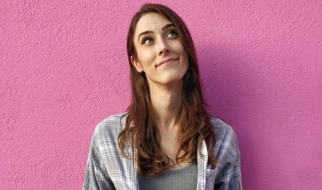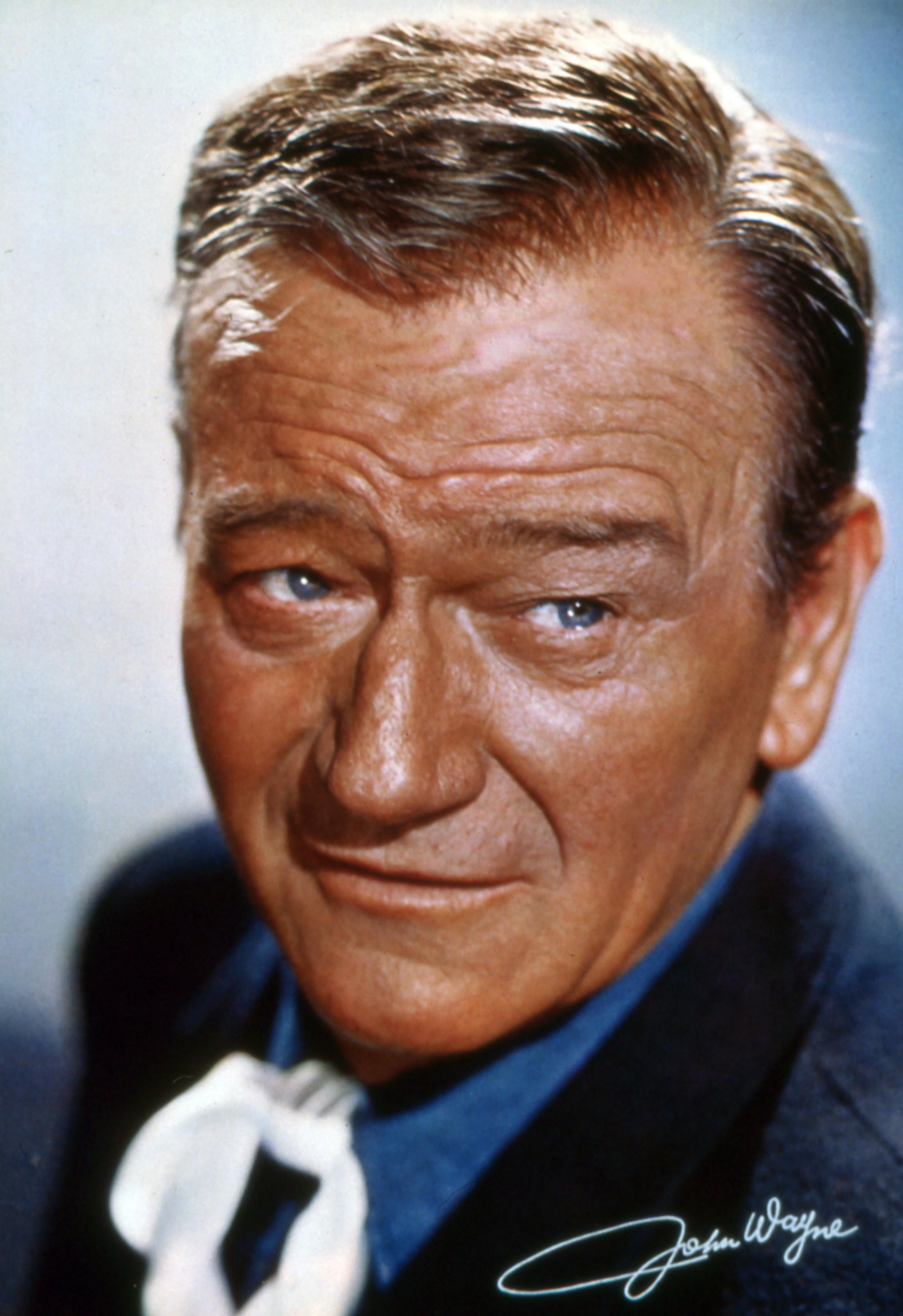 Actor Patrick Wayne grants his most comprehensive digital interview to date marking the 110th birthday of his late father, iconic cowboy hero John Wayne. Here the Duke cuts a dashing profile as Matt Masters, owner of a combination circus / Wild West show traveling throughout the capitals of Europe and molded after real life colorful cowboy Buffalo Bill Cody. ?Circus World,? a barely remembered, bloated drama unveiled on June 25, 1964, was directed by Henry Hathaway of later ?True Grit? blockbuster status. Wayne had a persistent, nagging cough during filming that eventually manifested itself as lung cancer. Note his stylized signature on the publicity still. Image Credit: AF Archive / Alamy Stock Photo
Actor Patrick Wayne grants his most comprehensive digital interview to date marking the 110th birthday of his late father, iconic cowboy hero John Wayne. Here the Duke cuts a dashing profile as Matt Masters, owner of a combination circus / Wild West show traveling throughout the capitals of Europe and molded after real life colorful cowboy Buffalo Bill Cody. ?Circus World,? a barely remembered, bloated drama unveiled on June 25, 1964, was directed by Henry Hathaway of later ?True Grit? blockbuster status. Wayne had a persistent, nagging cough during filming that eventually manifested itself as lung cancer. Note his stylized signature on the publicity still. Image Credit: AF Archive / Alamy Stock Photo
Born on May 26, 1907, smack dab in middle America ? the rural central Iowa community of Winterset ? Oscar-winning True Grit actor John Wayne embodied the quintessential everyman during his record 25-year streak ensconced in Quigley?s Top Ten Money Making Stars Poll.
Patrick Wayne, the Duke?s third of seven progeny, was lured by Hollywood?s bright lights to emulate his hero father?s formidable footsteps, starting with his blink and you?ll miss it bit part in the elder Wayne?s 1950 archetypal cavalry flick Rio Grande. Patrick received no screen billing but pocketed ten dollars as a belated recompense. Over the ensuing 47 years, the charming, likable personality tallied 74 films and television guest spots.
Among his siblings, Patrick?s acting aspirations no doubt engendered a tinge of envy as he got to spend invaluable time on faraway locales alongside his towering 6-foot-4, 240-pound father shooting 10 movies plus three TV productions. ?I was quite often alone with my dad,? admits Patrick. ?I didn?t have to share him or compete with my brothers and sisters for his attention.?
Developing a rsum as a busy character actor in the ?50s and ?60s but never quite stumbling upon the right part that would launch him into the stratosphere, Patrick did come close after screen testing and being cast as the titular role in 1978?s blockbuster Superman. His dad?s precipitous health forced Patrick to drop out, paving the way for Christopher Reeve to subsequently become a household name. An Eye for an Eye, Big Jake, Disney?s The Bears and I, The People That Time Forgot, Sinbad and the Eye of the Tiger, and Rustler?s Rhapsody represent Patrick?s best performances.
In an exclusive interview, the 81-year-old retired actor and current Chairman of the Board of the John Wayne Cancer Institute saddles up for a no-holds-barred glimpse behind a movie star?s cardboard cutout, tough guy persona to reveal a multi-faceted, at times self-doubting genuine article?s keen sense of humor who ?never lost touch with his humble beginnings and was comfortable with anybody.? A man whose presence was so electrifying that ?he could walk into a room and everything would come to a standstill.? Fiercely protective of his family and proud of his country although his unapologetic conservative values relentlessly rankled members of the loyal opposition, the Duke exhibited true grit where it counted throughout an agonizing ordeal with stomach cancer where even his second son believed, ?This guy is bulletproof. He is gonna survive.?
 In character as Lieutenant Colonel Kirby Yorke, a mustachioed John Wayne and son Patrick Wayne frame a majestic blue sky while filming ?Rio Grande? circa June 1950 in Moab, Utah. ?Rio Grande? was the final installment of director John Ford?s esteemed cavalry-themed trilogy. Image Credit: Sunset Boulevard / Corbis via Getty Images
In character as Lieutenant Colonel Kirby Yorke, a mustachioed John Wayne and son Patrick Wayne frame a majestic blue sky while filming ?Rio Grande? circa June 1950 in Moab, Utah. ?Rio Grande? was the final installment of director John Ford?s esteemed cavalry-themed trilogy. Image Credit: Sunset Boulevard / Corbis via Getty Images
The Patrick Wayne Interview
How would you characterize John Wayne?s sense of humor?
I would say my dad had a terrific sense of humor, a bit on the dry side. It wasn?t really something that he employed in film. There?s just a handful of films where you get any sense of his humor [e.g. Trouble Along the Way, North to Alaska, Hatari!, Donovan?s Reef, McLintock!]. But he had plenty of humor. He was quick on his feet.
I remember an incident that happened during the whole Vietnam controversy, roughly six years after the release of The Green Berets, which was also a very controversial film. The Harvard Lampoon Club invited him to Cambridge, Massachusetts, for a Hasty Pudding award and subsequent roast. He accepted their proposition.
I was visiting him the weekend before he was gonna leave, and I woke up in the middle of the night at about 2:30. I heard something and got up to find my dad pacing around. I went, ?What?s the matter?? He replied, ?Oh God, I don?t know what?s gonna happen at Harvard. I don?t know if they?re gonna tear me apart.?
I said, ?Don?t worry. You?re gonna be great. They?re gonna love you.? He had no self-awareness about what his presence was and how he would be accepted even though everywhere he went he was always accepted. I think that?s part of his charm.
He showed up at Harvard on an armored personnel carrier, standing up on top like he was going down the road for a parade. Immediately, these people cheered for him because they respected him, even if they didn?t necessarily agree with his politics. He just put it right in their face.
The liberal club students did their darndest to provoke an angry reaction from my dad during the roast. He was asked what he thought about women?s liberation. He said, ?A woman should have the right to go to work and pursue a career that she wants as long as she has my dinner on the table at 6 p.m. [laughs]. Another student yelled at him, ?Hey, you wear a toupee!? Then somebody yelled, ?Is that real hair?? My dad shot right back, ?Hell, yes, it?s real. It?s not mine, but it?s real.? He was pretty slick on the uptake.
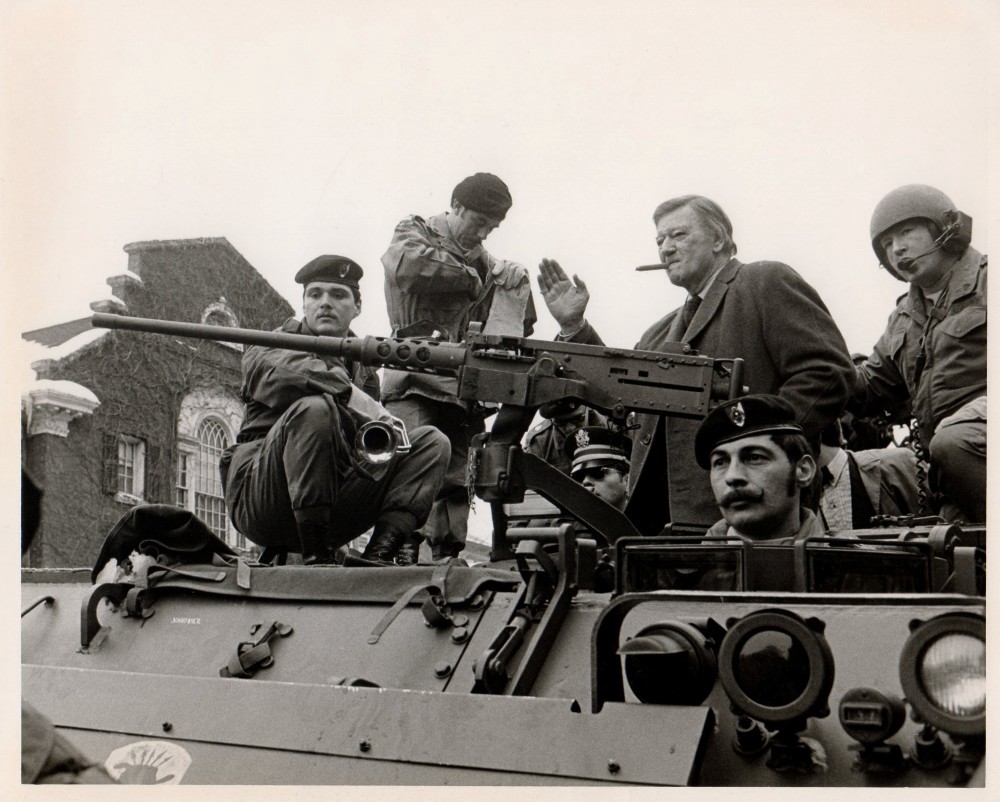 Cigar-chomping box office champion John Wayne confidently rumbles into Harvard Square on a 13-ton Army personnel carrier to battle liberal college students in this January 15, 1974 photo. The Duke was on hand to collect the Harvard Lampoon?s Brass Balls Award. Image Credit: DukeWayne.com forum / Las Bugas Collection
Cigar-chomping box office champion John Wayne confidently rumbles into Harvard Square on a 13-ton Army personnel carrier to battle liberal college students in this January 15, 1974 photo. The Duke was on hand to collect the Harvard Lampoon?s Brass Balls Award. Image Credit: DukeWayne.com forum / Las Bugas Collection
The Duke seemed like a very down to earth person ? what you saw was what you got.
Most assuredly. My dad was one of these people whose presence was show stopping. He could walk into a room and everything would come to a standstill. I?m not kidding. Everybody would stop and look.
By the same token, in five minutes he could just charm you into being totally relaxed and comfortable, especially if you were a good-looking woman. Being charming and easy-going came naturally to him.
He came from very humble beginnings ? the eldest of two brothers born to a poor family in Iowa. He had a football scholarship to the University of Southern California (USC), which he lost because he broke his shoulder. So he had to go to work. He was very determined to succeed.
Fortunately, my dad landed on his feet in a country where if you were willing to work hard, you had an opportunity to succeed. He never lost touch with his humble beginnings and was comfortable with anybody ? royalty, truck drivers ? it didn?t matter from what walk of life you came from, he was as nice and charming to you as he could be.
 A wider shot demonstrates the capacity Harvard Square crowd greeting John Wayne on a 13-ton Army personnel carrier on January 15, 1974. The Duke was on hand to collect the Harvard Lampoon?s Brass Balls Award, a fitting trophy if ever there was one for America?s genuine article. Image Credit: DukeWayne.com forum / Las Bugas Collection
A wider shot demonstrates the capacity Harvard Square crowd greeting John Wayne on a 13-ton Army personnel carrier on January 15, 1974. The Duke was on hand to collect the Harvard Lampoon?s Brass Balls Award, a fitting trophy if ever there was one for America?s genuine article. Image Credit: DukeWayne.com forum / Las Bugas Collection
Was it difficult being the son of John Wayne as far as your friends were concerned?
Not really. But my friends grew up with me. They knew who I was and who my dad was. My dad, in a sense, was also growing up and becoming more and more important, and more and more well known. It was happening to all of us in my close circle of friends.
I have friends that I went to grammar school, high school, college ? the same fraternity ? and they?re still my friends. I have this close circle of friends that were there from the beginning of both almost his career and my life.
Did your dad ever get angry at you when you were growing up?
Absolutely. Are you kidding? Plenty of times. But the thing about it was his presence. All he had to do was walk in. He never had to spank or threaten. That was the last time you were gonna do anything honestly. Sometimes you slipped and did stuff but typically you were on your best behavior. You didn?t want this menacing person to come and confront you.
You learned early on what your parameters of behavior were. How far you could go this way, how far you could go that way. If you?re stayed within those parameters, you were gonna do okay. If you drifted out of ?em, you were gonna hear from him. So that part was nice. If you painted something on the wall one time, he might say, ?Oh, isn?t that cute?? If you foolishly painted on the wall again, you got your brains beat out. This guy was pretty consistent.
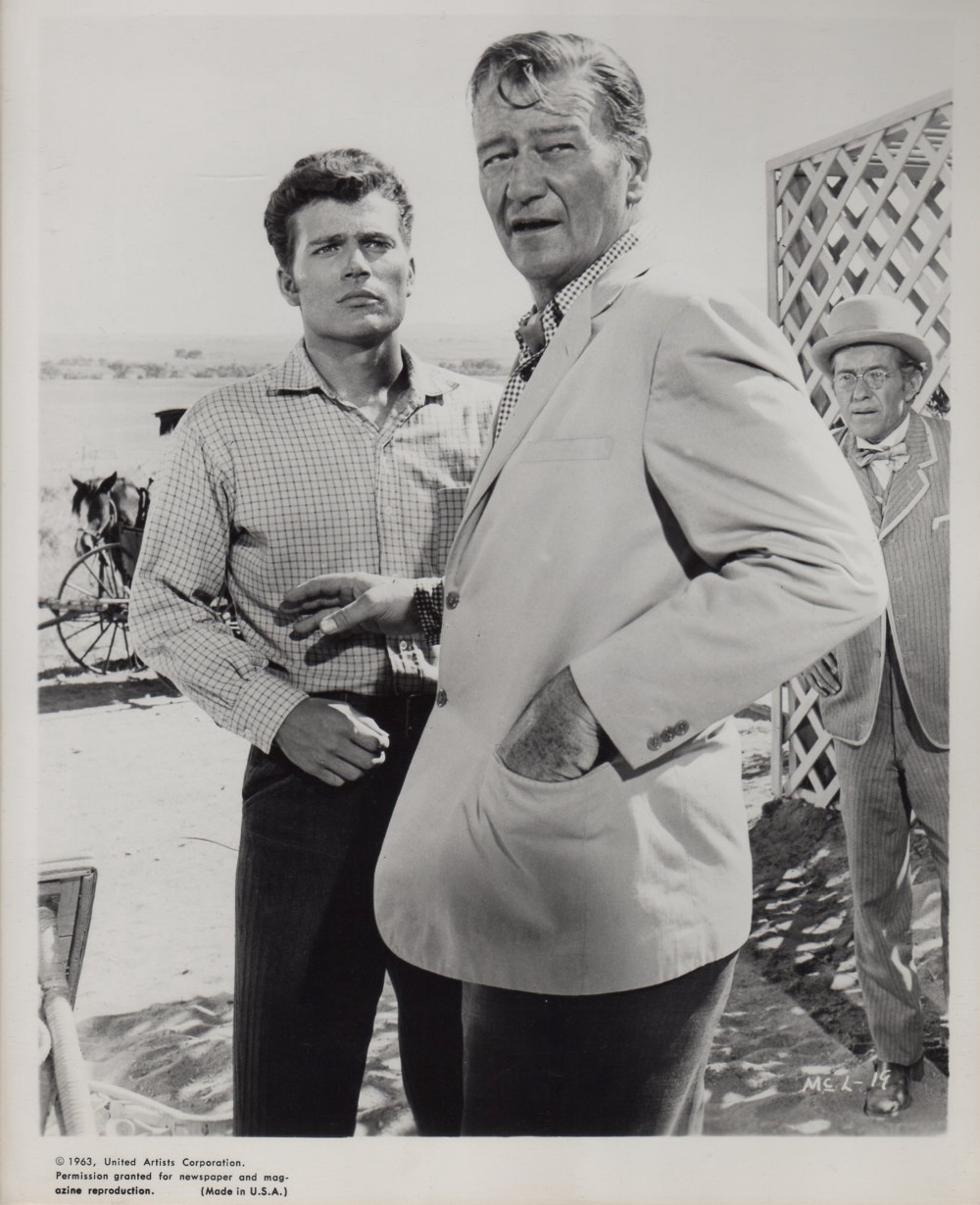 As wealthy, hard-nosed cattle baron George Washington ?G.W.? McLintock, John Wayne and son Patrick Wayne butt heads in the entertaining ?McLintock!,? a comedy Western released on November 13, 1963. That?s irascible scene-stealing character actor Strother Martin portraying an incompetent Indian agent at far right. Image Credit: Metro-Goldwyn-Mayer / DukeWayne.com forum / Las Bugas collection
As wealthy, hard-nosed cattle baron George Washington ?G.W.? McLintock, John Wayne and son Patrick Wayne butt heads in the entertaining ?McLintock!,? a comedy Western released on November 13, 1963. That?s irascible scene-stealing character actor Strother Martin portraying an incompetent Indian agent at far right. Image Credit: Metro-Goldwyn-Mayer / DukeWayne.com forum / Las Bugas collection
Sounds like you didn?t go through a period where you tried to rebel against your parents. You were a good kid.
I thought I was a good kid. I did have a period where I let my hair grow ? I had a beard and all these different things. The timing was really bad on the beard because my dad had his house robbed [May 1970].
The thieves had stolen $20,000 worth of prized memorabilia, mainly guns. He owned an AK-47 that was given to him by a Montagnard tribe while he was touring military bases in Vietnam [June 1966].
He always claimed it was druggies, these long-haired hippies, that stole his stuff. When I looked like that, he said, ?Oh, for God?s sake.? He accused me of being one of those people. They left a bad taste in his mouth.
Right at that time, I had just bought a house. I had a security guard coming over to tell me how to set an alarm up. My dad came over and said, ?What?s going on?? I replied, ?He?s putting an alarm in my house.?
He continued, ?Well, how about my house?? My dad was living in Newport Beach in Orange County. ?Mr. Wayne, I can?t do it because I can?t service it. It?s too far away. But I?d be very happy to come down and walk through the house and give you some suggestions.? So the guy goes down there and examines my dad?s home.
I saw the security guard three weeks later and he said, ?Oh my God!? ?What happened?? ?I went down to your dad?s house, we went all through the house, and then we sat down in the den afterwards having coffee.
?I was describing to him the way I thought the alarm could be set up and what he should do. Your dad had this frown on his face as he was listening to me. I said to him, ?Mr. Wayne, do you have some questions or concerns about what I?m talking about here???
My dad said, ?What I thought is if someone broke into the house, a tape recording of my voice could go off saying, ?I see you, you son of a b ? ch.?? My dad was dead serious. The security guard had to bite his lip to keep from laughing because he knew my dad wasn?t kidding. That would have been a pretty good alarm.
That would have stopped a burglar dead in his tracks if he had suddenly heard your dad?s authoritative, booming voice.
Anybody. More than a Rottweiler. Oh my God, that would have been great. My dad had some good ideas [laughs].
 As Colonel Mike Kirby, John Wayne directs son Patrick Wayne and a partially obscured Edward Faulkner in ?The Green Berets,? a still controversial Vietnam war film released on July 4, 1968. Patrick played Lieutenant Jamison, a Navy engineer proficient at driving bulldozers. Image Credit: Photography by David Sutton / Warner Bros.
As Colonel Mike Kirby, John Wayne directs son Patrick Wayne and a partially obscured Edward Faulkner in ?The Green Berets,? a still controversial Vietnam war film released on July 4, 1968. Patrick played Lieutenant Jamison, a Navy engineer proficient at driving bulldozers. Image Credit: Photography by David Sutton / Warner Bros.
Anytime I catch The Comancheros, McLintock!, The Green Berets, or Big Jake on television I think it?s so cool to see you acting alongside your dad. I get to search for subtle clues, whether in the dialogue or a brief knowing glance, acknowledging that the two characters interacting onscreen could be mirroring their real life father-son relationship.
[Laughs]. It was always more than just acting and working in movies, it was a chance to be with my dad. Of course, as a younger boy none of my siblings were interested in working in films, so I was quite often alone with my dad. I didn?t have to share him or compete with my brothers and sisters for his attention.
That was another bonus about escaping to Rio Grande, The Searchers, Donovan?s Reef, or any of the 10 movies that I was fortunate enough to make with him. Those times when me and my dad were together were plenty of fun and can never be replicated.
According to both costar Stuart Whitman and stuntman Dean Smith, the Duke unofficially directed half, if not more, of The Comancheros, released roughly a year after he helmed his long gestating pet project, The Alamo. Since you were there as the wet-behind-the-ears Texas Ranger nicknamed ?Tobe? ? your death scene was emotionally driven home through your dad?s eyes as you were shockingly dumped out of a multi-colored Comanche Indian blanket ? do you concur with their assessment?
The Comancheros was the last film that Michael Curtiz of Casablanca fame directed. He was in pretty bad shape with cancer, and we were in a very horrible location in Moab, Utah. The temperatures exceeded 100 degrees Fahrenheit with high humidity.
It was pretty tough on anybody ? I was a young man in good shape but I still remember feeling exhausted once temperatures climbed in the afternoon [Curtiz passed away on April 10, 1962 at age 75, five months after the release of The Comancheros].
My dad was helpful. I?m sure that I had never ever seen or worked with him when he wasn?t very involved in expressing his opinion on how something should be done or shouldn?t be done [laughs].
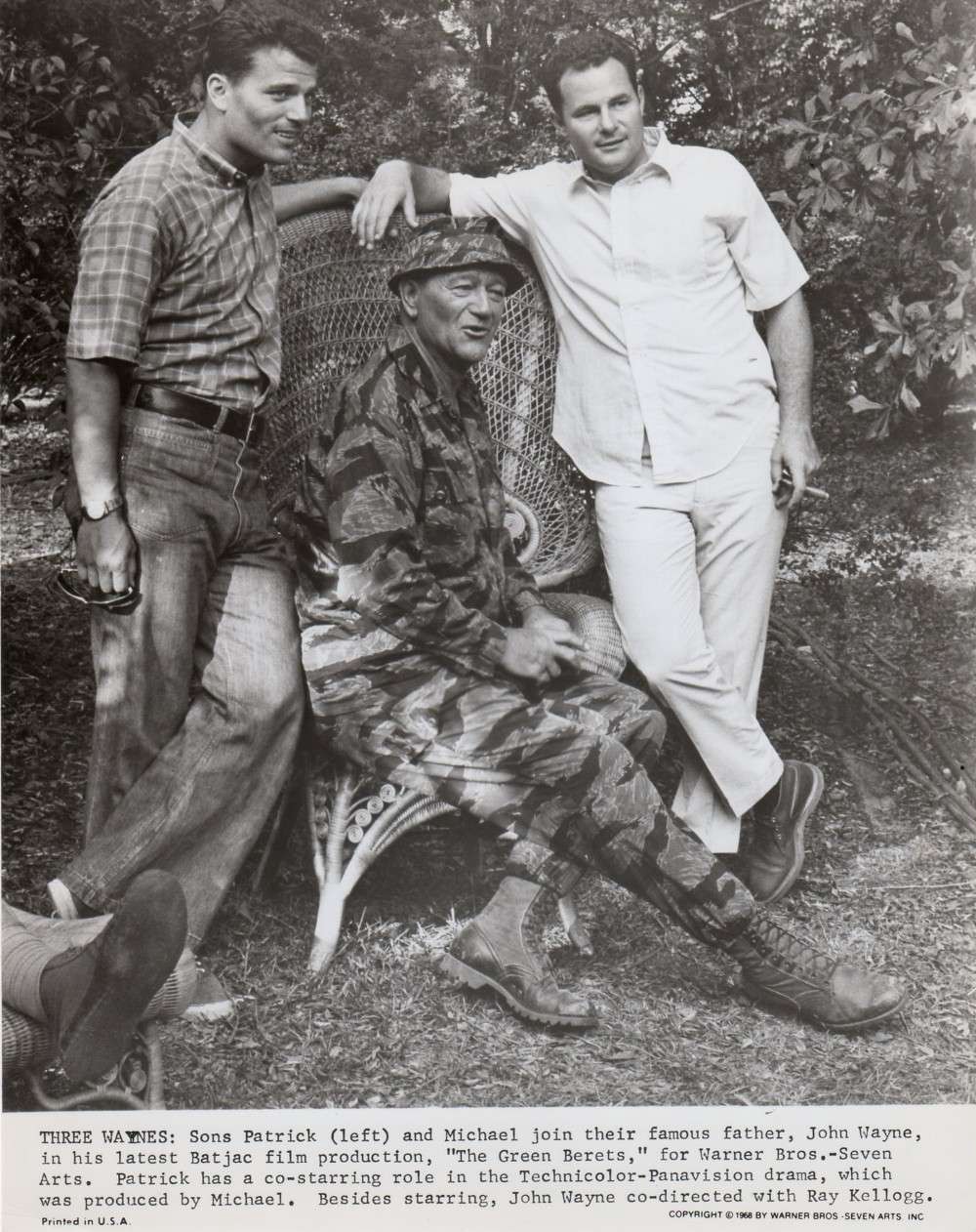 Sons Patrick [left] and Michael join their famous father John Wayne on the set of ?The Green Berets? in Fort Benning, Georgia, circa September 1967. The Duke directed and starred in the film, Michael served as producer and Patrick had a supporting role. Image Credit: Photography by David Sutton / Warner Bros. / Las Bugas Collection
Sons Patrick [left] and Michael join their famous father John Wayne on the set of ?The Green Berets? in Fort Benning, Georgia, circa September 1967. The Duke directed and starred in the film, Michael served as producer and Patrick had a supporting role. Image Credit: Photography by David Sutton / Warner Bros. / Las Bugas Collection
What was the worst film location that you engaged in with your dad?
That would have to be The Green Berets. We were on location at Fort Benning in Columbus, Georgia, which is located about 125 miles west of Atlanta. But it was nothing like Atlanta.
Oh my God, it was pretty dreary. That?s fine but it started raining to the point of where we couldn?t even work. Boy, there was nothing to do except sit there and wait ?til it stopped raining. It was a pretty miserable experience from the weather aspect at that time [filming commenced on August 9, 1967]. It was past the worst part of the summer, so the humidity wasn?t that bad.
After Big Jake was unleashed in 1971, was there another opportunity to work with your dad that just never came to pass?
Actually, there wasn?t anything. Occasions for us to work together onscreen just came from time to time. If there was a film and a role available in it, I was always in the priority position, but it never worked out.
Did your dad require you to audition for any of the roles that you did with him?
Absolutely not. Can you imagine? He was the only person I worked for that I didn?t have to audition for [laughs].
One of my favorite latter-day John Wayne movies is The Cowboys.
Mine too. Maureen O?Hara asked me to be one of her special guests when she was presented with an honorary Academy Award by Clint Eastwood and Liam Neeson at the Governors? Ball in Hollywood [November 8, 2014].
Honorary Oscars were also given to Harry Belafonte, filmmaker Hayao Miyazaki, and screenwriter Jean-Claude Carriere. It?s a really great, wonderful evening because everybody knows who?s gonna win. There?s no competition or infighting. Everybody is there to honor them.
I happened to see Laura Dern there and I said, ?I?ll never forgive your father for killing my dad in The Cowboys.? She started to chuckle and replied, ?Every day while filming that Western your dad would come up to my dad and say, ?You?re ruined. You?re dead. Your career is over. Nobody gets away with killing John Wayne?? [laughs].
Laura told me her dad had a pretty good retort: ?Maybe, but in Berkeley I?ll be a f ? -ing hero.? My father was saying this in jest. He had a great deal of respect for Bruce, too [Wayne?s shocking death scene in The Cowboys was filmed on July 13, 1971, on a Warner Brothers soundstage in Burbank].
I admire Bruce Dern. He was definitely bold to accept such an intense, villainous role. Even the child actors appeared to be genuinely afraid of him.
Exactly. Bruce will typically give you a performance like that, and he didn?t disappoint. The Cowboys was a hit at the box office and featured a great director in Mark Rydell in addition to fantastic performances from my dad and all of his costars including Bruce and Roscoe Lee Browne.
 Three of John Wayne?s children along with seven grandchildren collide on the Warner Bros. backlot during the filming of ?The Shootist? in early March 1976. Back row, left to right are Anita La Cava Swift, Brigid La Cava Casey, Toni Wayne La Cava, Kevin La Cava, John Wayne, and Patrick Wayne. Standing on the front row are David La Cava, Daniel La Cava [aka actor Brendan Wayne], Christopher John La Cava, Peter La Cava, and Marisa Wayne. Patrick, Toni, and Marisa are the Duke?s children. Seven of Toni?s eight children are pictured ? son Mark La Cava is not present. Marisa is wearing turn of the 20th century clothing since she had a bit part in ?The Shootist,? incidentally her film debut. Image Credit: Photography by David Sutton / The Peter La Cava Collection
Three of John Wayne?s children along with seven grandchildren collide on the Warner Bros. backlot during the filming of ?The Shootist? in early March 1976. Back row, left to right are Anita La Cava Swift, Brigid La Cava Casey, Toni Wayne La Cava, Kevin La Cava, John Wayne, and Patrick Wayne. Standing on the front row are David La Cava, Daniel La Cava [aka actor Brendan Wayne], Christopher John La Cava, Peter La Cava, and Marisa Wayne. Patrick, Toni, and Marisa are the Duke?s children. Seven of Toni?s eight children are pictured ? son Mark La Cava is not present. Marisa is wearing turn of the 20th century clothing since she had a bit part in ?The Shootist,? incidentally her film debut. Image Credit: Photography by David Sutton / The Peter La Cava Collection
A couple of years after The Shootist, as your dad?s health declined he became enthusiastic about a proposed movie entitled Beau John, going so far as to purchase the film rights through Batjac before the manuscript was in galley proof. A complete departure from the actor?s tried and true cowboy persona, the Duke would have portrayed a family patriarch in a small Kentucky community during the 1920s. Demonstrating light comedy overtones, Beau John was scheduled to reunite Ron Howard with his Shootist costar and be directed by the hot shot Peter Bogdanovich. Do you remember your dad speaking about his final, unrealized project?
I remember hearing about it. What the details were, I couldn?t tell you. But it is a fact that that was one amongst other movie projects that he had hoped to do. Oh my God, he loved working. He loved everything about show business.
My dad was able to keep making commercials and special guest appearances on television, but I know deep down he wished that he could have made another movie if his health hadn?t been so precarious [Author?s Note: Besides cancer, the eternally restless spirit faced bouts with prostate infection, gall bladder surgery, hepatitis, pneumonia, and open heart surgery during the last three years of his life].
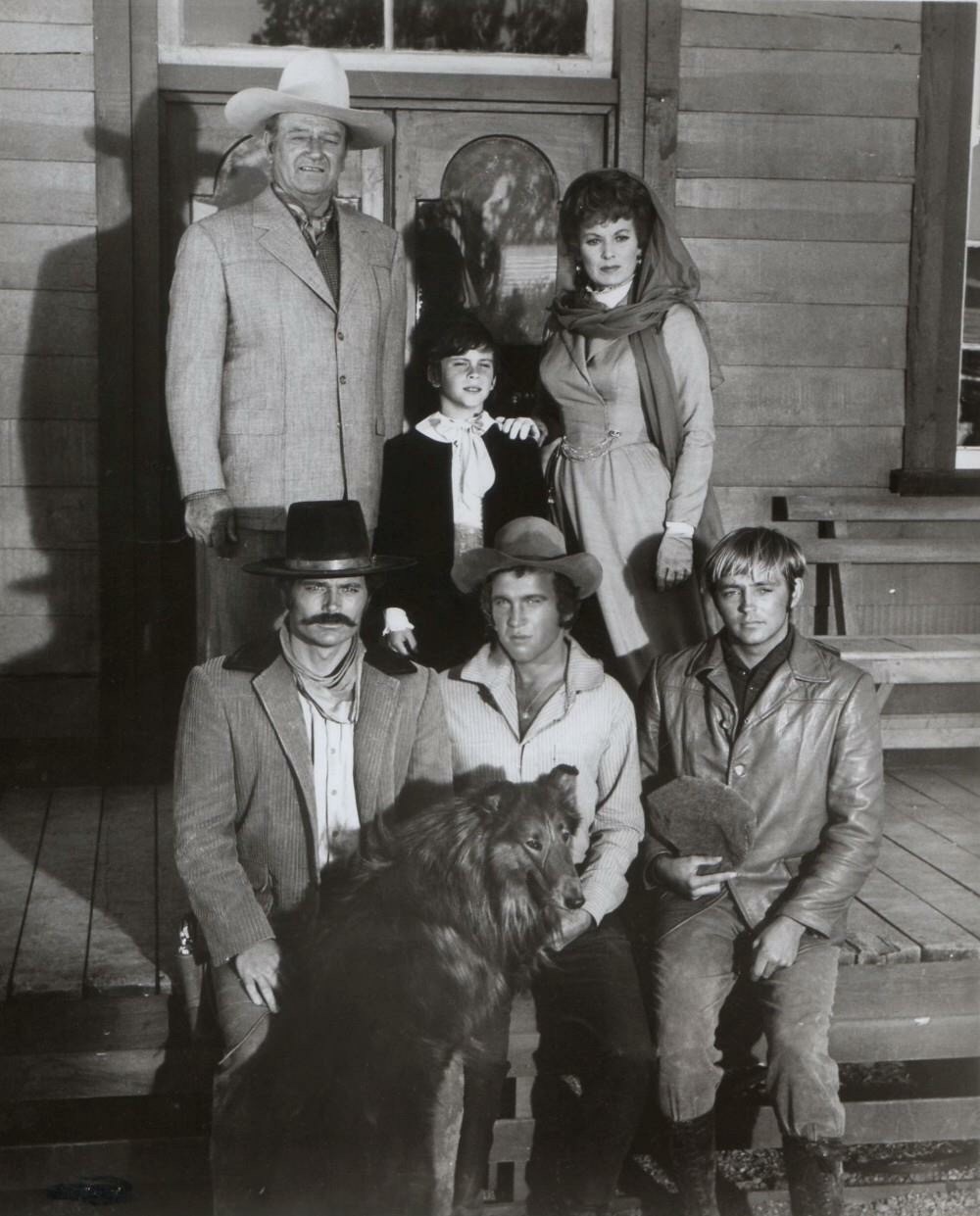 Clockwise from top left: John Wayne, son Ethan Wayne, Maureen O?Hara, Chris Mitchum (son of Robert Mitchum), singer Bobby Vinton, and son Patrick Wayne pose on a railroad depot porch in Durango. ?Big Jake? debuted on May 26, 1971, the Duke?s 64th birthday. Image Credit: Photography by David Sutton / Paramount Pictures
Clockwise from top left: John Wayne, son Ethan Wayne, Maureen O?Hara, Chris Mitchum (son of Robert Mitchum), singer Bobby Vinton, and son Patrick Wayne pose on a railroad depot porch in Durango. ?Big Jake? debuted on May 26, 1971, the Duke?s 64th birthday. Image Credit: Photography by David Sutton / Paramount Pictures
Did you appear on The Tonight Show Starring Johnny Carson? The Duke guest starred on multiple occasions.
Yes, I did. That was a very strange experience. In fact, I went on there with Chris Mitchum, son of Robert Mitchum, to promote Big Jake. My dad wasn?t there.
You walk out onto the stage, Johnny starts the interview, and I?m talking to him. As I was looking at him I thought, ?God, this guy is just cold as a cucumber. What does he have against me? Why is he being so cold, disconnected, and unengaged??
They broke for commercial, and Johnny turned around to talk to sidekick Ed McMahon. It was a short interview with maybe one commercial break, and then we were out of there. I went back to the hotel. The Tonight Show was shot in the afternoon, and later that night they aired our episode [June 4, 1971].
I was watching it, and I saw none of what I had experienced when I was actually in Johnny?s presence. Johnny looked engaged, connected, and warm on television. I guess that?s who he was. He was just kind of a disconnected, cold guy in real life. But you had no sense of it when The Tonight Show actually was being shown on television. So, that?s just weird. I never quite figured that one out.
It?s such a shame that your Tonight Show episode was apparently erased or recorded over by NBC executives. It?s unavailable on Carson?s official clip licensing website. That cost-cutting measure impacted 95% of the comedy series? first 10 seasons. By 1972 the renowned monologist realized what was happening and seized control of his vast Tonight Show archives. During a July 26, 1979 interview with Christopher Reeve plugging Superman II, Carson discussed his debut gig as host of the Academy Awards three months earlier. He revealed that he didn?t know your dad really well, although they had interacted at social functions as well as on The Tonight Show. About 10 days after an obviously emaciated Duke presented the Oscar for Best Picture to The Deer Hunter, Carson received a letter at his home saying, ?Dear Johnny, I just wanted to tell you how appreciate I was of how gracious you were to me, and how comfortable you made me feel during the Academy Awards. You did a wonderful job. Signed, Duke Wayne.? Carson added, ?My God. Here?s a guy who?s got all these personal problems and still took time out while he was in the hospital to send a note like that. It meant a great deal. That was special. People can do things, but boy when you do them when you?re down like that, it?s something else.?
My dad was really good about that. He was a really exceptional letter writer and really very appreciative. If he said that, he meant it. That?s impressive that he would take the time to write a letter even when he honestly wasn?t able to do so.
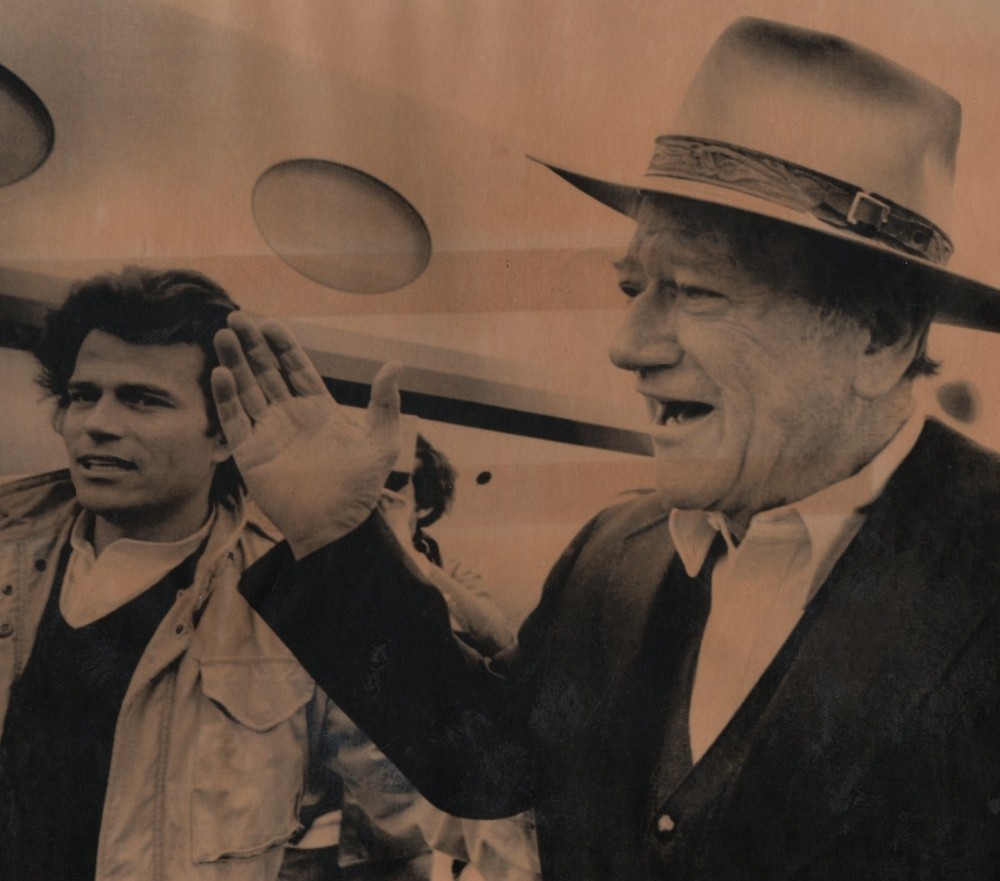 John Wayne and son Patrick Wayne greet fans upon arrival at Orange County Airport in Santa Ana on April 27, 1978. The Duke had just undergone major surgery in Boston to replace a defective heart valve and would succumb to stomach cancer 14 months later. Image Credit: Photography by Steve Rice / Los Angeles Times / Las Bugas Collection
John Wayne and son Patrick Wayne greet fans upon arrival at Orange County Airport in Santa Ana on April 27, 1978. The Duke had just undergone major surgery in Boston to replace a defective heart valve and would succumb to stomach cancer 14 months later. Image Credit: Photography by Steve Rice / Los Angeles Times / Las Bugas Collection
When you reexamine the last eight months or so of your dad?s life when the cancer returned with a vengeance, is there anything that you would have done differently as far as his treatment?
That?s an interesting point you make. I don?t know what the doctors at UCLA Medical Center knew at the time. I can tell you that the earlier the cancer is detected and treated, the better your chances are of having a positive result.
My dad told his doctors very early on, ?Look, I had lung cancer. I know what cancer is, and I know I have cancer.? He felt like he had broken glass in his gut by November 1978 and was nauseated by the smell of food except fruit.
They X-rayed, scoped, and did all of these various things to diagnose if it could be cancer. The doctors insisted that he did not have cancer. They argued, ?It?s all stress and strain-related. There?s nothing else it can be.?
About three months after he was supposedly cleared of it, he went in for an exploratory gallbladder operation [January 11, 1979], the day after taping his final on-camera interview with ABC News reporter Barbara Walters.
When the doctors were in there, they took a biopsy of his stomach and found the cancer in the lining of the stomach. It was not on the outside or the inside, so it was very hidden from all ways that they could have diagnosed it, except by this method.
Now, had they done the exploratory surgery three months earlier, who?s to say? If they got to it earlier, who?s to say? These doctors were only men. They were just human beings. They did the best they could with what they had.
Had my dad had that happen to him today, it probably would have had a much different result. I can say that with assurance. Had he had his lung cancer in 1964 or ensuing stomach cancer today, it would have been a much different treatment.
In addition, my mother?s chemotherapy for ovarian cancer would have been much more bearable. In the period that she took chemotherapy she went from an independent, self-reliant woman to a very nervous, lost all her self-confidence, very dependent, very clingy individual. Just a totally different human being.
Three months after she stopped taking the chemotherapy ? boom ? she was back to her old self again. The chemo was so debilitating. It was so bad. They?ve really done a lot in terms of making the chemotherapy a much more bearable concept.
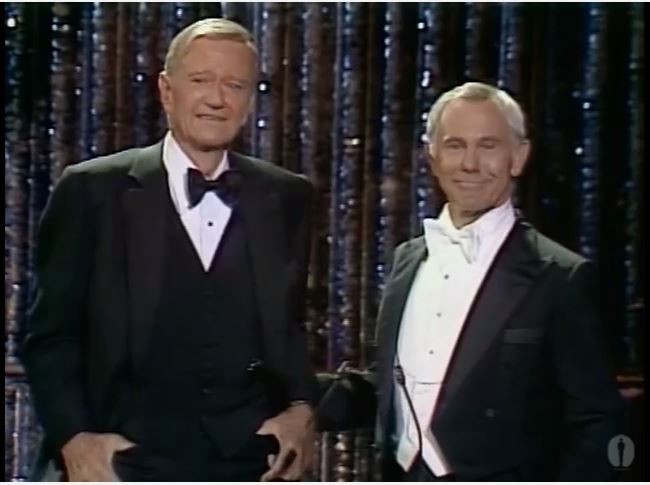 ?Oscar and I have something in common. Oscar first came to the Hollywood scene in 1928. So did I. We?re both a little weather-beaten, but we?re still here and plan to be around a whole lot longer.? On April 9, 1979, an emaciated but distinctly handsome John Wayne and 51st Academy Awards first-time host Johnny Carson wish the 46.3 million-strong audience inside the Dorothy Chandler Pavilion in Los Angeles a good evening moments after the former presented the Best Picture Oscar to ?The Deer Hunter,? a film he vehemently despised. Image Credit: The Oscars / ABC / Screen Grab
?Oscar and I have something in common. Oscar first came to the Hollywood scene in 1928. So did I. We?re both a little weather-beaten, but we?re still here and plan to be around a whole lot longer.? On April 9, 1979, an emaciated but distinctly handsome John Wayne and 51st Academy Awards first-time host Johnny Carson wish the 46.3 million-strong audience inside the Dorothy Chandler Pavilion in Los Angeles a good evening moments after the former presented the Best Picture Oscar to ?The Deer Hunter,? a film he vehemently despised. Image Credit: The Oscars / ABC / Screen Grab
When the Duke made his final public appearance at the Oscars on April 9, 1979, not many folks realized that he had endured chemotherapy earlier that very morning.
It was awful. The thing is that he never complained about any of it. I?m thinking to myself, ?Well this guy is bulletproof. He is gonna survive.? The docs kept saying, ?One more week, two more weeks? ? his cancer ordeal kept going on and on. I was so sure that my dad would somehow beat the cancer. Granted, he got weaker and weaker and weaker yet he never ever complained.
The last victory to my dad?s life is where I saw his true courage and character revealed. You can endlessly debate the merits of playing, doing, and behaving as a valiant character in a movie which my dad effortlessly did all the time.
Movies and real life are two entirely different subject matters, but he exhibited true grit where it counts ? in real life. I would have locked myself in a room and not talked to anybody. I don?t know what I would have done. I can?t imagine this man?s courage. It?s just amazing.
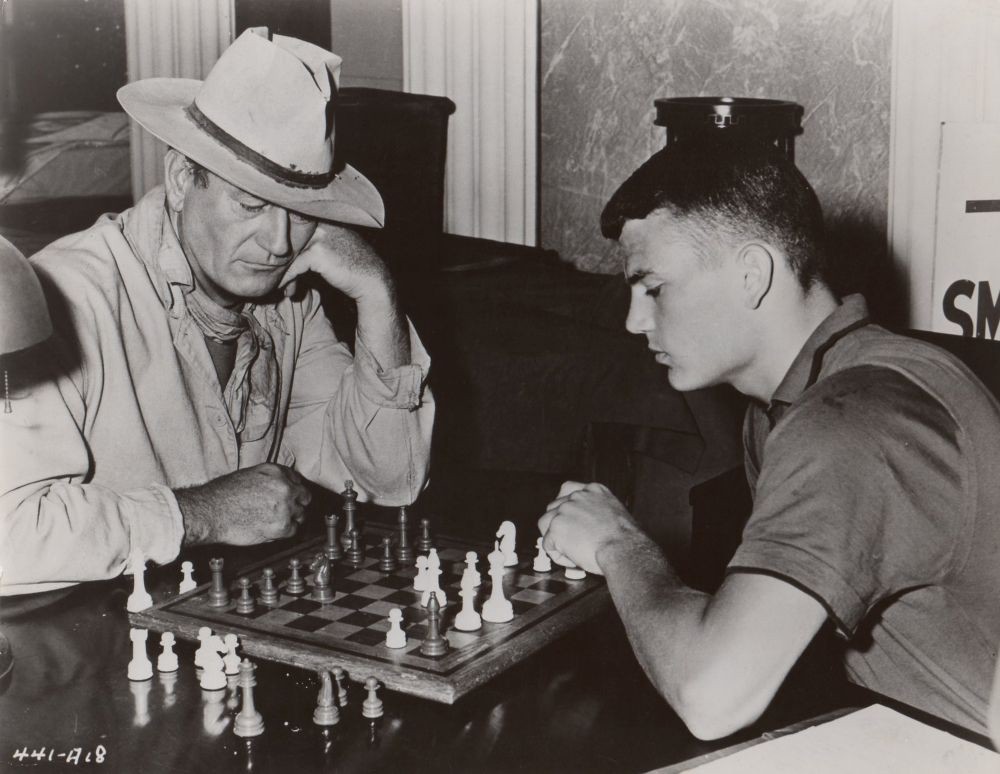 Dressed as Sheriff John T. Chance, John Wayne plays chess on the set of director Howard Hawks? classic ?Rio Bravo? with son Patrick Wayne circa May 1958. Duke relished the game and was often guilty of cheating unless an opponent nixed his skullduggery. Image Credit: DukeWayne.com forum / Las Bugas collection
Dressed as Sheriff John T. Chance, John Wayne plays chess on the set of director Howard Hawks? classic ?Rio Bravo? with son Patrick Wayne circa May 1958. Duke relished the game and was often guilty of cheating unless an opponent nixed his skullduggery. Image Credit: DukeWayne.com forum / Las Bugas collection
What do you recall about your final conversation with your dad?
He went into a coma at UCLA about a week before he passed away. On a Saturday night ? two days before he died ? he came out of his coma and engaged us in a conversation.
We just talked and laughed. He talked to each of us individually and understood what we were saying for about two hours. Then he went back to sleep. He just forced himself to wake up and say goodbye to all of us ? which I didn?t know at the time.
I thought, ?This is a sign he?s gonna get better.? Thirty-eight hours later, he passed away [at 5:23 p.m. PST on June 11, 1979]. At the time you think, ?Oh my God, he?s rebounding, he?s bouncing back.? Sadly, that wasn?t the case at all. It was just that he wanted to say goodbye to everybody around him and those close to him.
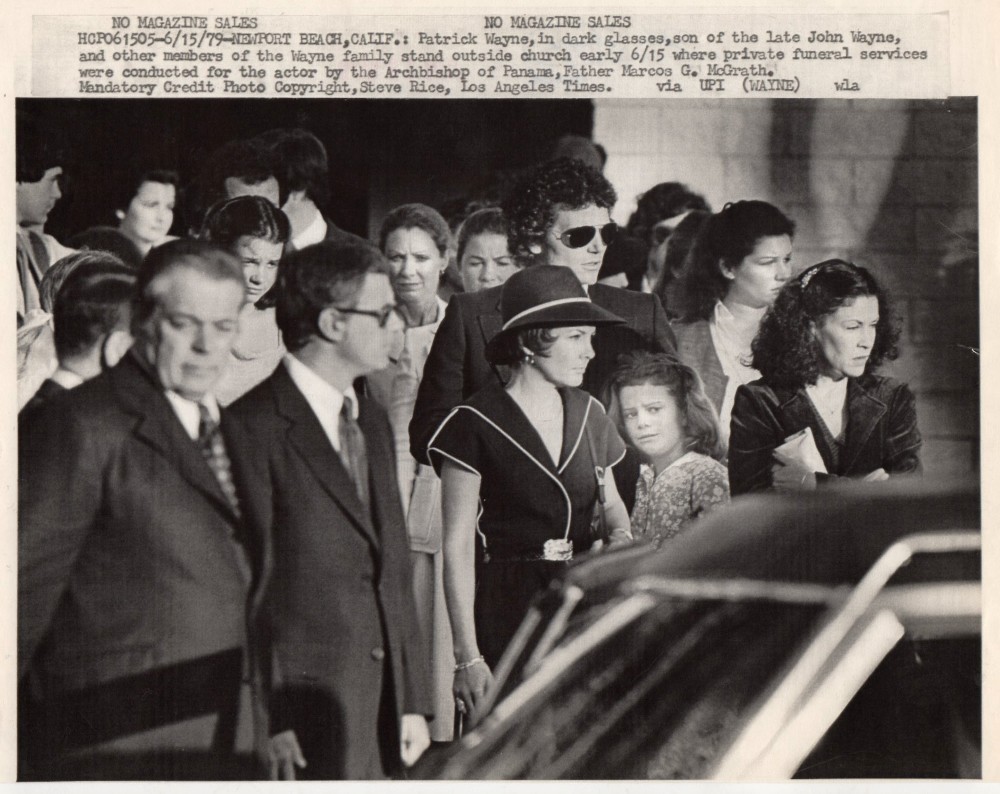 John Wayne?s secretary and final companion Pat Stacy [center with black hat], son Patrick Wayne [directly behind Stacy in sunglasses], and other family members stand outside Our Lady Queen of the Angels Catholic Church in Corona del Mar on June 15, 1979, for the iconic actor?s private funeral service. Image Credit: Photography by Steve Rice / Los Angeles Times / Las Bugas Collection
John Wayne?s secretary and final companion Pat Stacy [center with black hat], son Patrick Wayne [directly behind Stacy in sunglasses], and other family members stand outside Our Lady Queen of the Angels Catholic Church in Corona del Mar on June 15, 1979, for the iconic actor?s private funeral service. Image Credit: Photography by Steve Rice / Los Angeles Times / Las Bugas Collection
In the years after your dad?s death, was it tough to revisit his films?
I?d have to say no to that question with the exception of one film, The Shootist. I couldn?t watch that Western as it was so close to reality. He played an old gunfighter who was an anachronism dying of cancer.
Too many of the elements in there were just too close to what actually happened to him in his real life, so that film took me about 10 years to watch again [of course I saw it when it was originally released in 1976].
When I did finally watch it for the second time, I have to say that it?s probably his finest performance as a pure actor, using all his skills and being more than just a cardboard cutout, but more of a real human being ? a vulnerable human being ? and I think he pulled it off really well.
 Like father, like son: John Wayne lovingly cradles newborn son Patrick shortly after his July 15, 1939 birth, possibly outside the Duke?s 312 North Highland Avenue, Hancock Park-Wilshire, Los Angeles home shared with first wife Josephine Saenz. Four months earlier Wayne?s star-defining turn in John Ford?s ?Stagecoach? was unleashed nationally, but he was still mired in an eight-picture contract for Herbert Yates? Republic Pictures portraying white-hatted hero Stony Brooke in the Three Mesquiteers B-Western series. ?Wyoming Outlaw? would have been playing on a matinee double bill when this snapshot was taken. Image Credit: The Patrick Wayne Collection
Like father, like son: John Wayne lovingly cradles newborn son Patrick shortly after his July 15, 1939 birth, possibly outside the Duke?s 312 North Highland Avenue, Hancock Park-Wilshire, Los Angeles home shared with first wife Josephine Saenz. Four months earlier Wayne?s star-defining turn in John Ford?s ?Stagecoach? was unleashed nationally, but he was still mired in an eight-picture contract for Herbert Yates? Republic Pictures portraying white-hatted hero Stony Brooke in the Three Mesquiteers B-Western series. ?Wyoming Outlaw? would have been playing on a matinee double bill when this snapshot was taken. Image Credit: The Patrick Wayne Collection
Compared to your dad?s widely documented life and career, relatively little is known about your mother, Josephine ?Josie? Saenz. What was she like?
My mom was just an amazing woman. She was a pillar of the community. She got married [June 24, 1933] and was gonna be a homemaker, and that?s basically what she did. She was involved in a lot of charity and social work. She was the den mother and Girl Scout mother. She had a great personality and led a very active social life.
She never granted an interview or wrote down any memories regarding my dad. Not a word. In that sense, she was a very private person. She was never really actively pursued by a journalist, either.
There?s still a monolithic studio system, but in my dad?s era each studio?s publicity department controlled the media pretty well. You didn?t have a lot of paparazzi. The movie studios pretty much kept everything under close wraps, except those stories that they wanted released.
After 53 years of being divorced from my dad, she got married again at age 87 to a 91-year-old man named Cyril Nigg who was a tremendously nice guy. I couldn?t believe that. They were married for three years until his death at age 94 in 1999. She lived another four years and died at 95 [June 6, 2003].
She really outlived everybody. She was very strong. Mom had had ovarian cancer in 1978, undergone chemotherapy, and then it was gone. But cancers never go away forever.
To be honest with you, my older sister Toni LaCava passed away in 2000, and then my oldest sibling, Michael, died in April 2003 from lupus complications. It was just too much for my mother. I really think she just gave up the ghost. It?s terrible. I can?t even imagine what it would be like to have one of my children predecease me.
She died of ovarian cancer only two months after Michael passed away. Her system was down, her resistance was very low, and the cancer had a chance to rear up again. The day before she died, she kind of lost it and became incoherent. But she went peacefully.
 John Wayne and fetching spouse Josie Saenz, the daughter of the Consul General of Panama in the United States, casually pose with first child Michael Wayne on a wooden dock overlooking the Pacific Ocean, summer 1935. Image Credit: John Wayne Enterprises
John Wayne and fetching spouse Josie Saenz, the daughter of the Consul General of Panama in the United States, casually pose with first child Michael Wayne on a wooden dock overlooking the Pacific Ocean, summer 1935. Image Credit: John Wayne Enterprises
A neighbor of mine named Janna was diagnosed with stage 1 ovarian cancer when she was only 16 years old. After undergoing a perilous operation, today she?s cancer free and living life to the fullest, exemplified by her passion for horseback riding, conquering the Miss Alapaha Station Beauty Pageant, and multiple college scholarships. Cancer has claimed so many immediate family members of mine, and I just want to thank you for funding research since you became Chairman of the Board of the John Wayne Cancer Institute upon your brother Michael?s death in 2003.
It is so amazing how cancer is sought out and treated, plus the medicines that they have now. It?s come so much farther down the road than when my mother and dad suffered from it. Not only the work we?re doing, but the work being done worldwide is astonishing. I?m thrilled to be a part of it.
I really feel that we can contribute many ideas to the big picture of cancer research. When I came on board at the Institute, they thought there were somewhere in the neighborhood of 250 different kinds of cancer. We know now there are at least 2,500 different kinds of cancer. It?s so interesting the work they?re doing with the genome and breaking markers up.
There?s a non-Hodgkin?s lymphoma which they?ve had great success using a certain protocol to serve about 80% of these patients. We?ve come to find out that there are actually two different kinds of this non-Hodgkin?s lymphoma, and the medicine actually cures 100% of the cases for this certain kind of non-Hodgkin?s lymphoma. It has no luck with the other one.
These are the kinds of crazy things that researchers are learning. In some ways, they?re still in the dark ages about finding a cure for cancer. So many of these diseases we treat as chronic disease like diabetes. We?ve come a long way and it?s been a great ride.
 Distributed by independent studio Avco Embassy Pictures in June 1966 is the DVD cover of intriguing Western ?An Eye for an Eye,? toplined by Robert Lansing and Patrick Wayne. Fun fact: Kurt Russell?s father Bing Russell, best known to cowboy aficionados as stalwart Deputy Clem Foster on the beloved ?Bonanza? series, co-wrote ?An Eye for an Eye.? Image Credit: Amazon / Lions Gate
Distributed by independent studio Avco Embassy Pictures in June 1966 is the DVD cover of intriguing Western ?An Eye for an Eye,? toplined by Robert Lansing and Patrick Wayne. Fun fact: Kurt Russell?s father Bing Russell, best known to cowboy aficionados as stalwart Deputy Clem Foster on the beloved ?Bonanza? series, co-wrote ?An Eye for an Eye.? Image Credit: Amazon / Lions Gate
The first movie that I ever saw you in that was not with your dad was an unusual, underrated Western from 1966 entitled An Eye for an Eye.
Yeah, that was a nice little film that not very many people saw. Robert Lansing did a great job himself. It was the first and only time where I had to be blind in a movie. I had to wear contact lenses, which were very scary. It was daunting since I couldn?t draw on an experience from my life. They just made me blind, and then you just gotta go with it.
It was filmed in Lone Pine, California, which is where a lot of my dad?s early B-Westerns were made. I?m pretty sure An Eye for an Eye was the only film I did up there. It was in an old, old detained mountain range called the Alabamas.
A great experience for me, and I got to work alongside Strother Martin, Paul Fix, and Slim Pickens, who all worked multiple times with my dad. Furthermore, Lucien Ballard was responsible for the cinematography, and he photographed my dad in both The Sons of Katie Elder and True Grit.
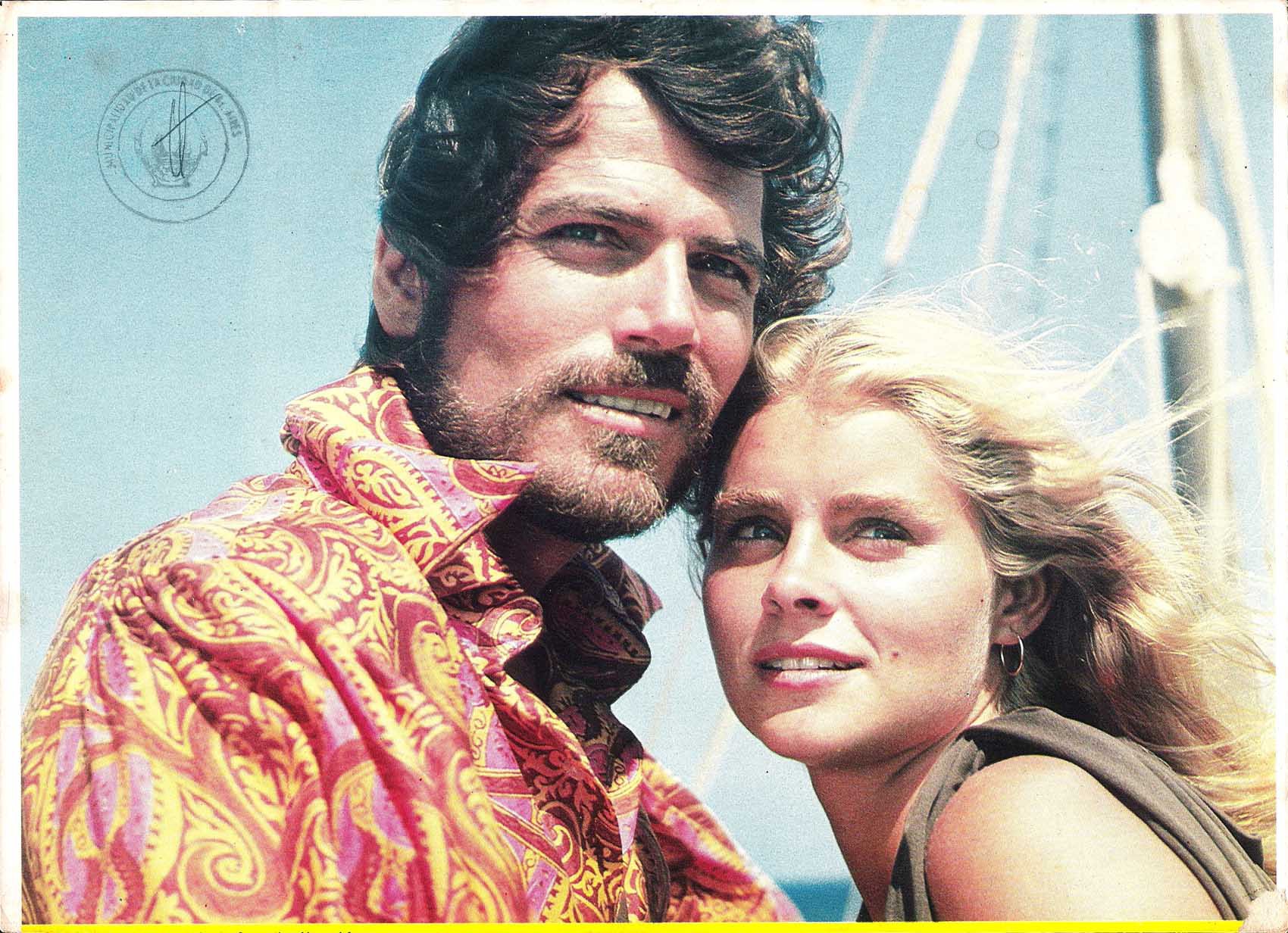 Unleashed on August 12, 1977, ?Sinbad and the Eye of the Tiger? teamed up the progeny of two classic Hollywood actors, Patrick Wayne ? son of John Wayne ? and Taryn Power ? daughter of Tyrone Power. The swashbuckler was directed by Sam Wanamaker, best known for the oft-neglected Western ?Catlow? featuring Yul Brynner. Image Credit: Sony Pictures Entertainment
Unleashed on August 12, 1977, ?Sinbad and the Eye of the Tiger? teamed up the progeny of two classic Hollywood actors, Patrick Wayne ? son of John Wayne ? and Taryn Power ? daughter of Tyrone Power. The swashbuckler was directed by Sam Wanamaker, best known for the oft-neglected Western ?Catlow? featuring Yul Brynner. Image Credit: Sony Pictures Entertainment
Which movies did you have the most fun shooting?
The most fun I ever had on a film was Sinbad and the Eye of the Tiger [1977] that I did where I played the title role. We were on location in Spain, Malta, Jordan, and England. Sinbad had a great group of people and a great cast.
With my dad, I?d have to say Big Jake was really the most fun I had. My younger brother Ethan was in the film, and my older brother Michael was producing it via Batjac. It was a little family affair. We were on location in a remote part of Mexico [i.e. Durango and Zacatecas], so your family tends to get closer when you don?t have a lot of distractions like television or whatever. Those would be the highlights.
I had a very small part in Rustlers? Rhapsody [1985], but it was probably the best acting I?ve done on film.
Where was Rustlers? Rhapsody filmed?
It was filmed in Almeria, Spain. I had done a miniseries in Japan and returned to the USA on a Tuesday. My agent sends this script over for Rustlers? Rhapsody, a comedic homage to 1940s B-Westerns costarring Tom Berenger, Andy Griffith, and Marilu Henner. I said, ?This is great.? He replied, ?That?s good, because you?re going Friday to Spain.?
What had happened was the producers had hired somebody to do the part that I was eventually asked to do. They shot the scenes with him and saw the dailies and didn?t like it. They were about to change locations. They needed to redo all of the stuff, and they needed to get an actor in there fast to do this stuff and move on.
My wardrobe was made that Wednesday in Los Angeles. I actually carried it with me on the plane. It was pretty fancy [laughs]. I traveled to Almeria on Friday, filmed on Saturday, and I was done on Tuesday. It was like boom, boom, boom, and then they were gone to a different location.
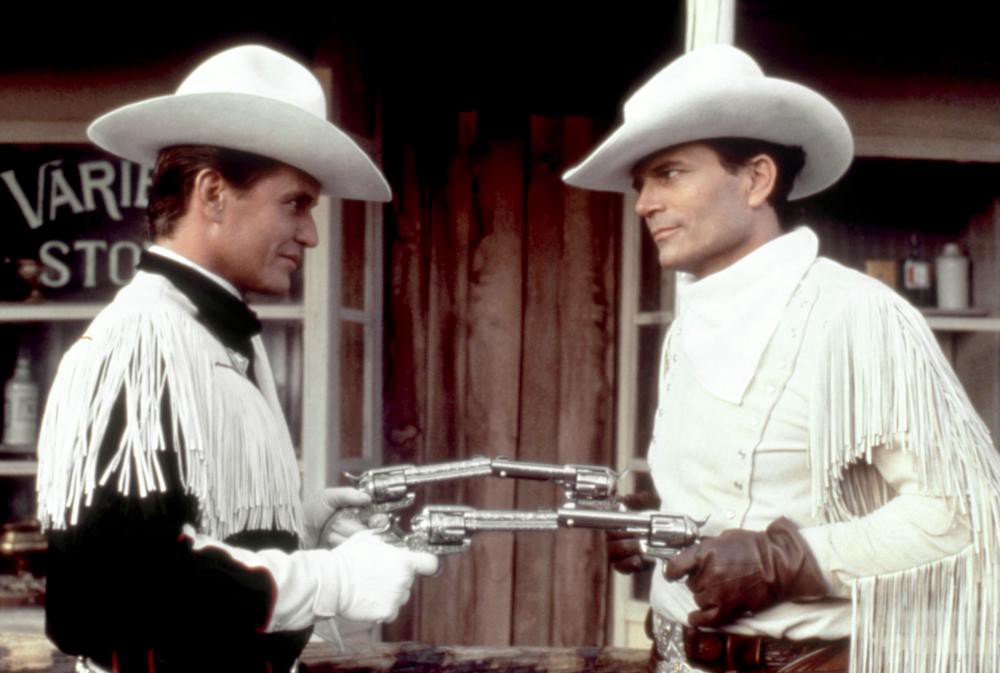 As singing cowboy Rex O-Herlihan, Tom Berenger [left] sizes up Wrangler Bob Barber [Patrick Wayne, the real-life son of iconic cowboy John Wayne] in a still from ?Rustlers? Rhapsody,? an underrated Western parody released quietly on May 10, 1985. Image Credit: Photography by Federico G. Grau / Paramount
As singing cowboy Rex O-Herlihan, Tom Berenger [left] sizes up Wrangler Bob Barber [Patrick Wayne, the real-life son of iconic cowboy John Wayne] in a still from ?Rustlers? Rhapsody,? an underrated Western parody released quietly on May 10, 1985. Image Credit: Photography by Federico G. Grau / Paramount
If Rustlers? Rhapsody had been released 25 years earlier, perhaps it would have found a wider audience.
It would have made much more sense, yeah. If your audience is between the ages of 18 and 26, they don?t even know what the B-Westerns were. They?ve never really had a chance to experience it. They didn?t get the parody nor the joke. But the older audiences pretty much got it. Unfortunately, they?re not the people that go to the movies, so you had a real paradox there.
Rustlers? Rhapsody was the last Western that I did, and it was really amazing. As far as whether or not a movie is gonna be a hit at the box office, you have no idea. All you can do is show up, do your job, and leave. The rest of it is all a roll of the dice.
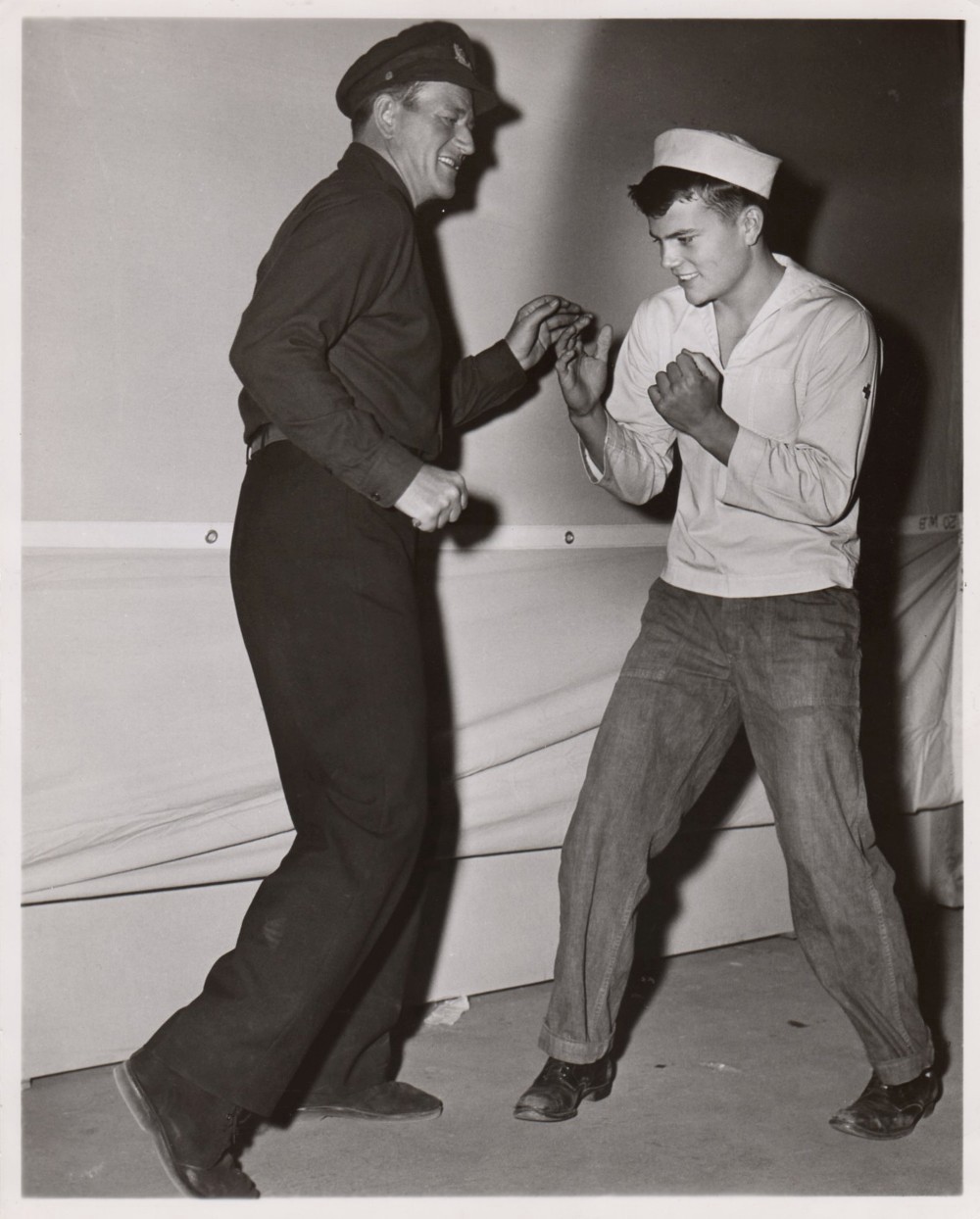 John Wayne playfully shadow boxes on the set of director John Ford?s ?Mister Roberts? with son Patrick Wayne in Kailua Bay, Hawaii, circa October 1954. At the time Duke was filming ?The Sea Chase,? and his son had a minor role in ?Mister Roberts.? Image Credit: Photography by Jack Woods / MPTV
John Wayne playfully shadow boxes on the set of director John Ford?s ?Mister Roberts? with son Patrick Wayne in Kailua Bay, Hawaii, circa October 1954. At the time Duke was filming ?The Sea Chase,? and his son had a minor role in ?Mister Roberts.? Image Credit: Photography by Jack Woods / MPTV
I?m always extremely edgy when I must stand in front of people and speak. Do you experience a similar predicament?
Not any longer. In 1980 I was the host of a short-lived, syndicated variety show in Monte Carlo appropriately named The Monte Carlo Show. It was really the first time I had done anything as myself, not as an actor performing a part. I was pretty naked and vulnerable hanging out there.
During that experience I had an epiphany: the people there in front of you were there for positive reasons. They wanted to be entertained, and they had all of this positive energy. If I just relaxed, I could really tap into that, and it kept me going. I was addicted to it.
That experience in Monte Carlo was a real eye-opener for me, and I was able to get over the nervousness about being in front of a group of people.
I was on a cruise ship one time. They were having a film festival about my dad, which I didn?t know about. On their in-house television, they had about 10 of my dad?s films that they were going to show during the cruise.
I was asked to make a presentation. I looked at the films that they had there, and I saw that I was either in six or seven or knew the story behind them. I wrote the names of each film on a piece of paper and made mental notes.
When it was time to deliver my talk, I looked at a name of a film, told a story about it, and then went on to the next film. I decided to also open the presentation up to question and answers. I talked for about 40 minutes and then started the Q&A segment for about 25 minutes.
Everybody loved it. The people on the cruise ship offered me an around the world cruise to go and do it again. Anyway, I never did do the around the world cruise, but it?s still on my bucket list. I have no problem today getting in front of a group of people, especially when they?re asking me questions that I know the answers to.
 Epiphone Dove acoustic guitar slinger-songwriter-vocalist Jennifer Wayne was born on April 1, 1982, three years after her grandfather John Wayne?s prolonged battle with stomach cancer ended. This winning candid was featured in the May 5, 2016 issue of Risen Magazine, right around the time Runaway June?s debut single, ?Lipstick,? landed squarely in Billboard?s Top 40 country singles chart. Image Credit: Risen Magazine
Epiphone Dove acoustic guitar slinger-songwriter-vocalist Jennifer Wayne was born on April 1, 1982, three years after her grandfather John Wayne?s prolonged battle with stomach cancer ended. This winning candid was featured in the May 5, 2016 issue of Risen Magazine, right around the time Runaway June?s debut single, ?Lipstick,? landed squarely in Billboard?s Top 40 country singles chart. Image Credit: Risen Magazine
Jennifer Wayne, your sister Aissa?s daughter, is following in your dad?s footsteps. The Duke infamously appeared as Singin? Sandy Saunders, the screen?s third singing cowboy following Ken Maynard and Bob Steele, in the 1933 Lone Star B-Western Riders of Destiny, although his singing voice was dubbed by Bill Bradbury, son of the film?s writer-director Robert Bradbury. The Duke can actually be heard singing in about a dozen of his later films, usually when he was sufficiently inebriated and in a celebratory mood. The Comancheros, McLintock!, Big Jake, Cahill: U.S. Marshal, and Rooster Cogburn spring to mind. And he released the spoken-word America, Why I Love Her on RCA Victor Records in February 1973. The album remained on Billboard for 16 weeks [No. 66 Pop, No. 13 C&W], earned a Grammy nomination in the Best Spoken Word category for the Duke and lyricist John Mitchum [a character actor best known as the younger brother of El Dorado costar Robert Mitchum], and received significant rediscovery 30 years later during the aftermath of September 11, 2001. I wish your dad had recorded a follow-up record.
Jennifer is following in my dad?s footsteps in a broad artistic sense, since he didn?t really have a singing career. Jennifer is actively pursuing the writing and singing of songs. She participated on an all-star edition of CBS?s The Amazing Race with friend Caroline Cutbirth in 2014 and is currently one third of the Nashville-based group Runaway June [acoustic guitar/vocals]. She?s pretty darn good.
What is interesting about singing for anything is that it?s a performance. If you listen to America, Why I Love Her, it is really exceptional because it is my dad?s performance. He is talking about something that he loves, and you have the sense of it when each word leaves his mouth. He?s very proud of his country, and he didn?t spare that when he made that album. There?s still a lot of interest in America, Why I Love Her. Every year, it continues to sell.
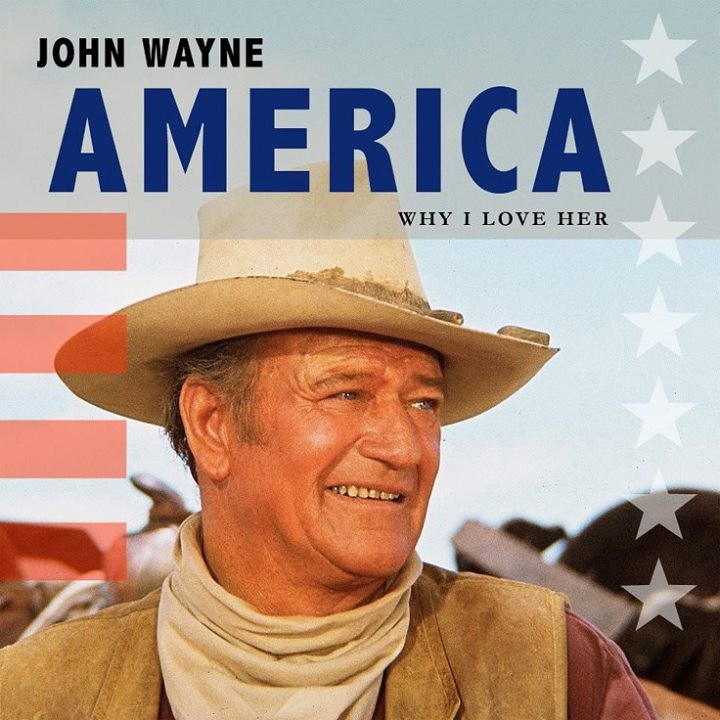 An alternate CD reissue cover of John Wayne?s ?America: Why I Love Her,? dropped on December 5, 2011?featuring an arguably better shot of the Duke taken on location in Durango, Mexico, circa April 1972 while filming director Burt Kennedy?s ?The Train Robbers.? Image Credit: Amazon / John Wayne Enterprises
An alternate CD reissue cover of John Wayne?s ?America: Why I Love Her,? dropped on December 5, 2011?featuring an arguably better shot of the Duke taken on location in Durango, Mexico, circa April 1972 while filming director Burt Kennedy?s ?The Train Robbers.? Image Credit: Amazon / John Wayne Enterprises
Where were you on the dreadful morning of September 11, 2001?
I was in Northern California in the middle of a ski trip. As I was browsing through a ski shop, a TV was playing. I heard the newscaster exclaim, ?Oh God, a plane has crashed into the World Trade Center! It?s a horrible accident.? At that time nobody realized that it was a terrorist attack.
While I was still in the shop, the second plane hit. Everybody was just stunned. It was just a horrible, horrible thing. I still have a vision of seeing that plane crash into that building on the television. It was awful.
 Fashionably draping a jacket over his shoulder, an 18-year-old Patrick Wayne opts for an ill-advised, close-cropped haircut on the single 45 cover of ?That?s Why? b/w ?Big Love,? credited to Pat Wayne and the Corsairs. Released by Dot Records in August 1958, the record regrettably failed to see any national chart action in Billboard. Neither tune is available digitally or via YouTube?so if you stumble upon a copy please share online with fellow Wayne fans. Image Credit: 45Cat user BoyJohn / Universal Music Group
Fashionably draping a jacket over his shoulder, an 18-year-old Patrick Wayne opts for an ill-advised, close-cropped haircut on the single 45 cover of ?That?s Why? b/w ?Big Love,? credited to Pat Wayne and the Corsairs. Released by Dot Records in August 1958, the record regrettably failed to see any national chart action in Billboard. Neither tune is available digitally or via YouTube?so if you stumble upon a copy please share online with fellow Wayne fans. Image Credit: 45Cat user BoyJohn / Universal Music Group
Are you musically talented?
I had a brief musical experience. I was on ?Teenage Idol? [aired July 8, 1958], the final episode of a brief two-season television sitcom called Mr. Adams and Eve which starred Howard Duff and his then-wife, Ida Lupino [the latter was also a maverick director of such films as The Hitchhiker and The Trouble with Angels].
I played a young boy who idolized a rock star named ?Swivelhips Jackson,? obviously modeled after Elvis and played by Darrell Howe. In the episode?s finale I ended up emulating Swivelhips and singing a song called ?That?s Why.? Dot Records decided to take me into the studio and record a 45 single with the big hole in the middle [credited to Pat Wayne and the Corsairs, the B-side was ?Big Love?].
I spent a summer touring around singing ?That?s Why.? I was even on Dick Clark?s American Bandstand. It was quite a fun experience, but music wasn?t something that I really wanted to pursue particularly. I let it fall by the wayside.
Perhaps John Wayne Enterprises can obtain a copy. Fans would love to hear it.
I don?t know. I?m not gonna go that far [laughs]. But it was fun.
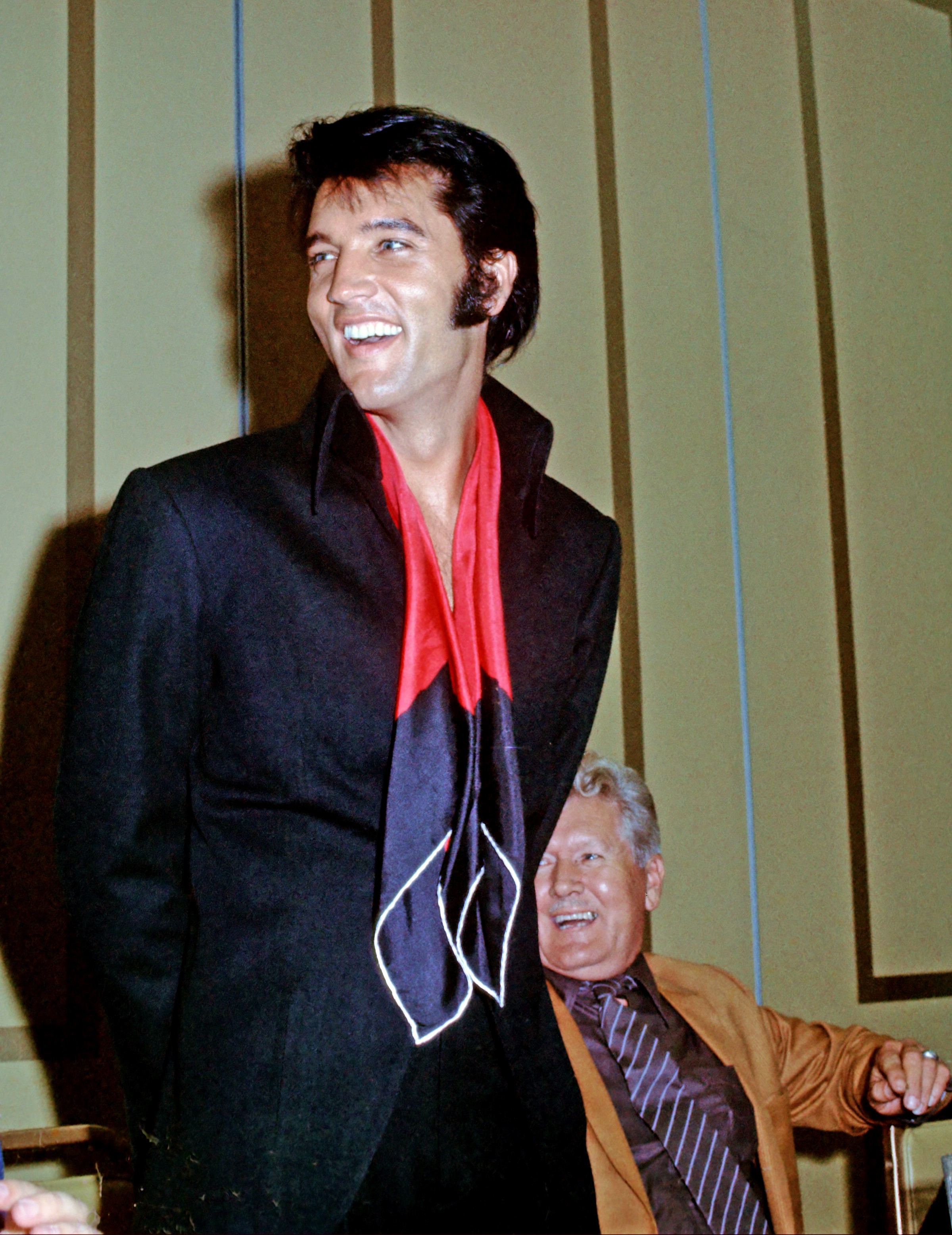 A beaming 34-year-old Elvis Presley, then thought of as a singing Hollywood has-been, confidently meets members of the press corps on August 1, 1969, in Las Vegas after roundly conquering opening night jitters at the International Hotel in his first live appearance in eight years. Father Vernon Presley chuckles in the background. Image Credit: Photography by Terry O?Neill / FECC Elvis-Collectors messageboard
A beaming 34-year-old Elvis Presley, then thought of as a singing Hollywood has-been, confidently meets members of the press corps on August 1, 1969, in Las Vegas after roundly conquering opening night jitters at the International Hotel in his first live appearance in eight years. Father Vernon Presley chuckles in the background. Image Credit: Photography by Terry O?Neill / FECC Elvis-Collectors messageboard
Is it true that you got to see Elvis Presley in concert?
It?s not only true, it?s kind of funny. I shot a little Western between April and May 1969 in Santa Fe, New Mexico entitled The Gatling Gun, costarring Robert Fuller, Guy Stockwell, Barbara Luna, and Judy Jordan.
Judy?s future husband Sonny West [who succumbed to lung cancer on May 24, 2017] was the head of security for Elvis. They arranged for my then-wife Peggy Hunt and I to attend an Elvis concert during his incredible comeback period [a midnight show on August 22, 1969, at the Las Vegas International Hotel, renamed the Westgate Las Vegas Resort & Casino].
It was fantastic. In the middle of the show, Elvis introduced me from the audience, which was very nice. Years later someone sent me a recording [Here I Go Again, an import soundboard released ?unofficially? in 1995]. Elvis?s introduction was in the album.
Were you an Elvis fan prior to the show?
Who wasn?t an Elvis fan? Yeah, I was a big, big time Elvis fan. He was great. My dad was an Elvis fan and certainly recognized the potential of Elvis. He wanted to do a film with Elvis. He did do a film with teen idol Fabian called North to Alaska, and he had Frankie Avalon in The Alamo [both released in 1960]. Colonel Parker was too tough of a negotiator, and they could never make a deal for Elvis to work with him.
Did your dad see Elvis in concert?
That, I couldn?t say. I?m not sure about that one.
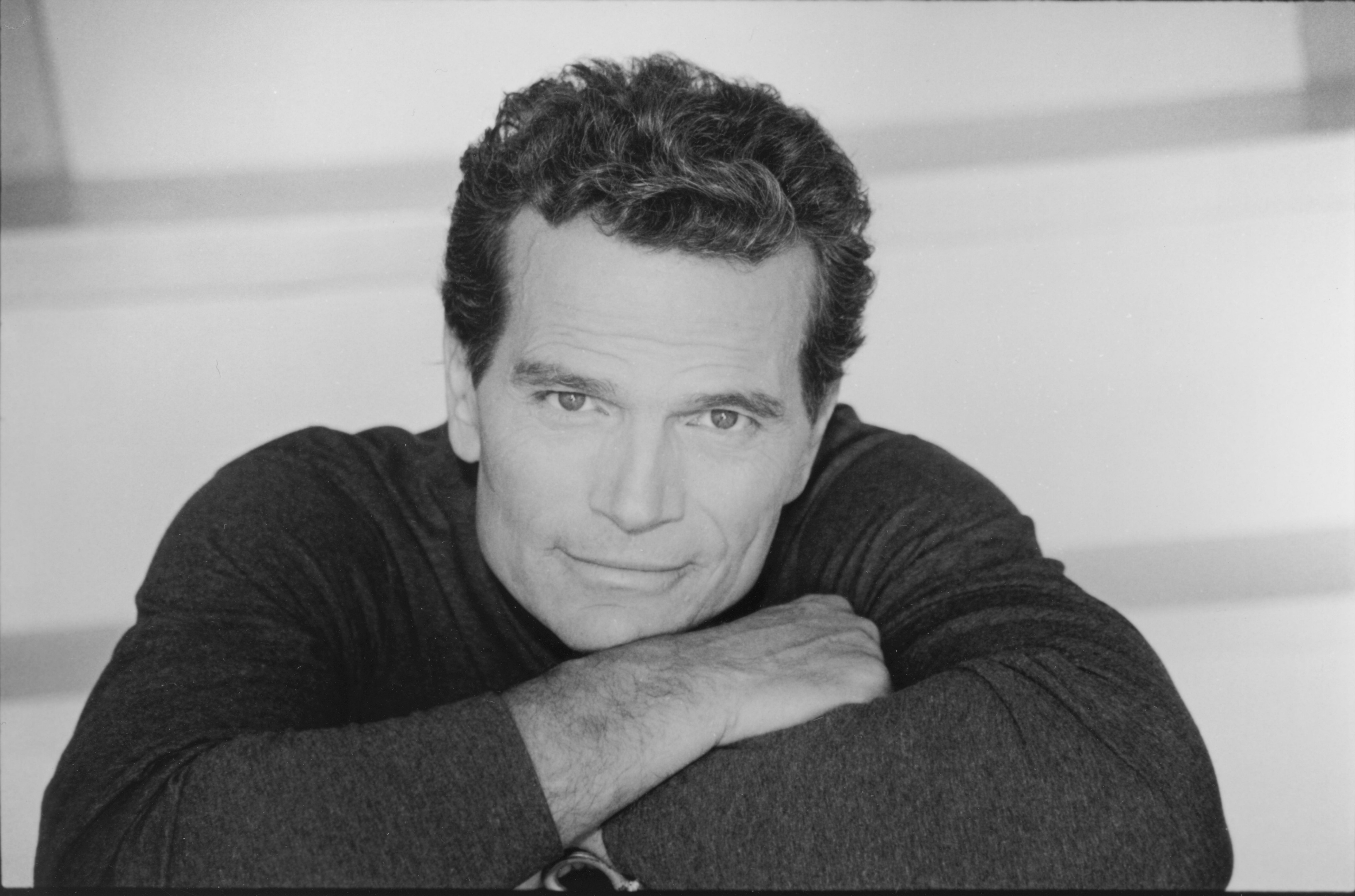 Taken circa 2002, the incredibly handsome Chairman of the John Wayne Cancer Institute Patrick Wayne co-starred with his iconic father in films such as ?The Green Berets? and crafted his own persona in the swashbuckler ?Sinbad and the Eye of the Tiger.? Image Credit: Courtesy of John Wayne Enterprises
Taken circa 2002, the incredibly handsome Chairman of the John Wayne Cancer Institute Patrick Wayne co-starred with his iconic father in films such as ?The Green Berets? and crafted his own persona in the swashbuckler ?Sinbad and the Eye of the Tiger.? Image Credit: Courtesy of John Wayne Enterprises
Would you make another movie if a role was offered to you?
Sure, absolutely. I love to work. Actually, trying to find work is a pain in the neck. But if somebody just came out of the blue and said, ?Hey, I?ve got a part. It?s gonna be from this time to this time,? I could work out my schedule and meetings and go work on it.
Work is great. It?s play acting. It?s like a kid?s game. It?s just all fun. Once the camera is rolling and you?re out there, it?s a piece of cake. Looking back over my career makes me feel like Walter Mitty [laughs]. Any role is a challenge and offers some challenges. To the extent that you?re able to arrive at who the character is and be that person is the reward. I?ve been fortunate to play a pretty broad range which gives me much satisfaction.
Have you considered setting up an official Patrick Wayne website? Fans could purchase autographed photos, DVDs, and exclusive memorabilia that could help raise funds for cancer research and treatment.
Well, we have the official John Wayne website. We have the John Wayne Cancer Foundation website. If anyone were to make an appeal or request, I?m pretty good about following up on that.
 Patrick Wayne explores an issue of Modern Luxury at the Highland Park Village Theatre on September 25, 2015, while participating in the 4th annual John Wayne Film Festival in Dallas. A portrait of fellow actor Paul Newman compliments the casual, low-key vibe ingenuously captured by photographer-half sister Marisa Wayne.
Patrick Wayne explores an issue of Modern Luxury at the Highland Park Village Theatre on September 25, 2015, while participating in the 4th annual John Wayne Film Festival in Dallas. A portrait of fellow actor Paul Newman compliments the casual, low-key vibe ingenuously captured by photographer-half sister Marisa Wayne.
What would your perfect day consist of?
I?ve had a lot of great days. I?m not really a hobby guy, like model plane building or anything like that. I like to hike. I like to walk. Attending baseball games is fun. I like to spend time with my kids and my grandkids. My three surviving sisters and brother [Melinda, Aissa, Ethan, and Marisa] live in Orange County, California, which is about 75 miles away from me. I wish we could see each other on a day-to-day basis.
I belong to a club in San Francisco called the Bohemian Club. Every summer, they have an encampment in the Redwoods by Santa Rosa, California. The encampment lasts three weekends and the two weeks in between, so it runs for about 17 days. It?s just for members.
The Bohemian Club is very hard to describe. In fact, when people described it to me before I ever went up there, I wasn?t very interested in going. I soon realized it was truly a wonderful experience. They?ve got entertainment at night, speakers during the day, and you get to socialize with friends. It?s pretty darn perfect.
You?re living the life and that?s what counts.
I?m living the life and enjoying every day. I?m thankful every morning I wake up.
Do you consider yourself to be a religious person?
I would say I?m a spiritual person. It?s pretty hard to not have a sense of something more than just walking around on a sitting planet. What keeps everything glued together? I don?t know what it is but I believe it?s something.
We could talk about the origin of that certain ?something? all day.
[Laughs].
What is John Wayne?s legacy?
The one thing I?d have to say that I am really stunned by is the fact that he still has his popularity and celebrity. If you had told me in 1980 that he would still be as popular today as he is, I would have said you?re crazy.
My dad is the paradigm for what it means to be an American, what it means to be in this country, and the opportunity that is available for everyone. He came from the humblest of beginnings. With hard work, perseverance, and drive, he was able to reach the height of his popularity and career. That basically tells everyone out there that if you?re willing to work hard, you can be a success.
Is there anything I haven?t asked that you would like to say to your fans?
No. Really, I appreciate the time we?ve had together. I?ve enjoyed the conversation.
*******************DON?T GO ANYWHERE YET*********************
Exclusive Interview: ?Dad had a few green Pontiac Grand Safari station wagons. They were customized by George Barris who did the Batmobile. When I was about five he would drive to L.A., put me on his lap, and make me steer. If I would start driving out of the lane he would yell, ?Hey ? get back in the lane!? and scare the crap out of me.? Ethan Wayne, costar of Big Jake and director of the John Wayne Cancer Foundation, jump starts a mesmerizing if laconic journey of his back pages in an exclusive interview entitled ?Gettin? Back in the Lane with John Wayne?s Youngest Son.?
Further Reading: John Wayne possessed no plans to retire after The Shootist opened to excellent reviews but middling box office receipts in August 1976. After open heart surgery two years later, the Duke was determined to begin work on Beau John. He went to impressive lengths to secure the screenplay, actually buying the film rights via Batjac, the first time that had happened since he unsuccessfully bidded for True Grit 10 years earlier. The legend also had plans to reunite with recent costar Ron Howard. To learn more about the one project that gave Wayne some much needed hope during his final days, head on over to ??Beau John?: The Untold Story of John Wayne?s Last Film Project.?
Exclusive Interview No. 2: In 2013 John Wayne?s family commissioned journalist Michael Goldman to explore the family archives of personal letters [i.e. correspondence between presidents, Steve McQueen, director John Ford, the president of the Harvard Lampoon after the Duke rode to the campus on a tank borrowed from Fort Devens] and rare documents, most of which had accumulated dust in unopened boxes hastily packed away in the hectic days following the naturally gifted actor?s tragically unfair demise in 1979. The only edict from the Duke?s son, Ethan, was to craft a portrait harnessing his dad?s own words. During Goldman?s research, he stumbled across a golden goose ? the cowboy actor?s unfinished memoir. In ?He Was Ugly, Strong, and Had Dignity: Uncovering John Wayne?s Hidden Treasure,? Goldman agreed to speak candidly with this writer about the current state of John Wayne Enterprises and his favorite archive discoveries. That?s just the tip of the iceberg.
Exclusive Interview No. 3: Starring James Drury in the title role, The Virginian is the third-longest running and first 90-minute western in prime time television. A humble, genuine cowboy in real life with intense passions for writing and flying, the octogenarian speaks eloquently in a new feature about his unexpected encounter with the one and only John Wayne, whether he had a role model in mind for his characterization of the Virginian, the 55th anniversary of his namesake series, and why he will always appreciate his fans. Click on either installment link above to begin the enlightening ride.
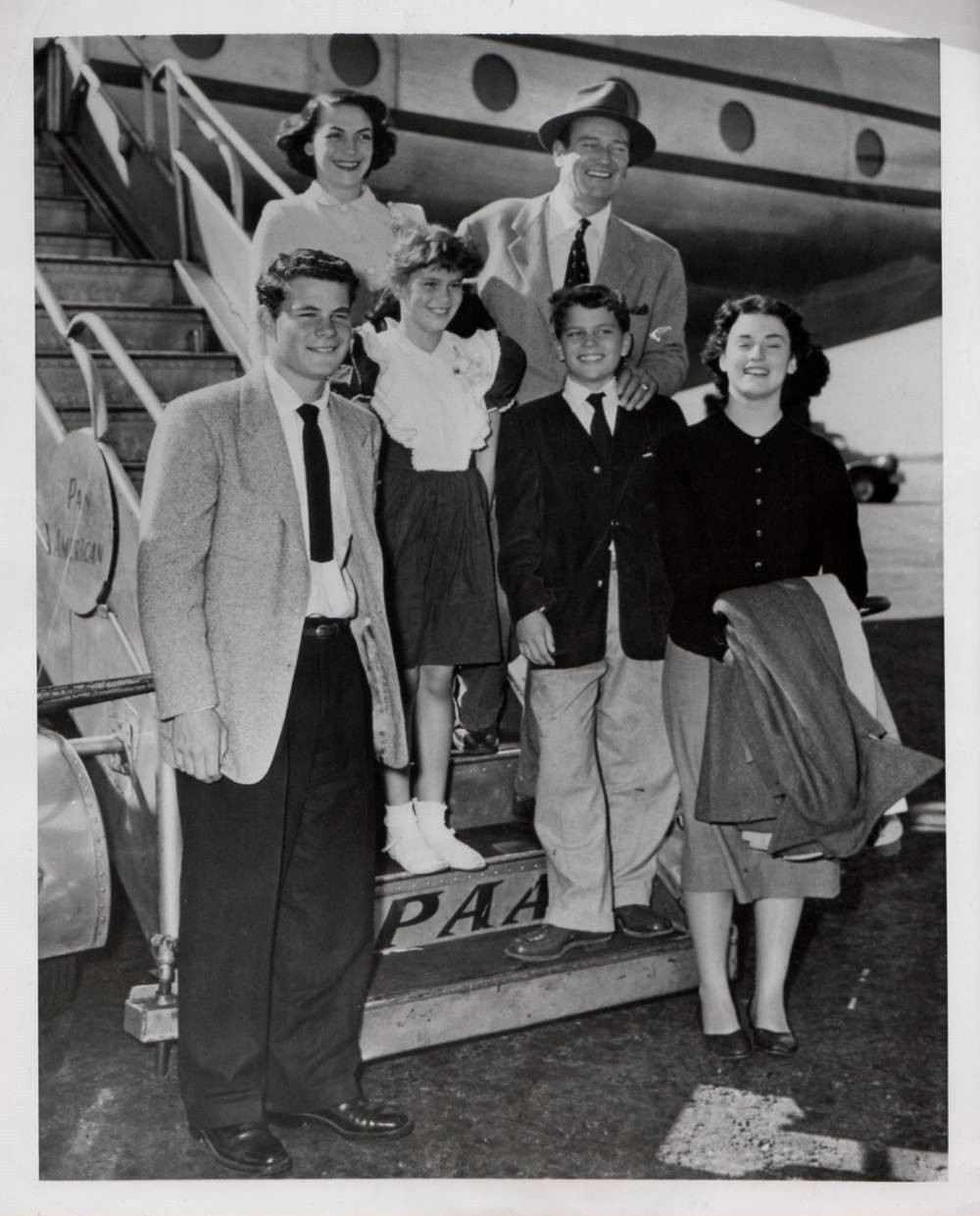 John Wayne and spitfire of a second wife Chata Baur Diaz arrive at New York?s International Airport on July 20, 1951 upon completion of director John Ford?s ?The Quiet Man.? Left to right are Wayne?s four kids with first wife Josie Saenz: Michael, Melinda, Patrick, and Toni. Patrick and younger sister Melinda are fortuitously still among the living. Image Credit: United Press International
John Wayne and spitfire of a second wife Chata Baur Diaz arrive at New York?s International Airport on July 20, 1951 upon completion of director John Ford?s ?The Quiet Man.? Left to right are Wayne?s four kids with first wife Josie Saenz: Michael, Melinda, Patrick, and Toni. Patrick and younger sister Melinda are fortuitously still among the living. Image Credit: United Press International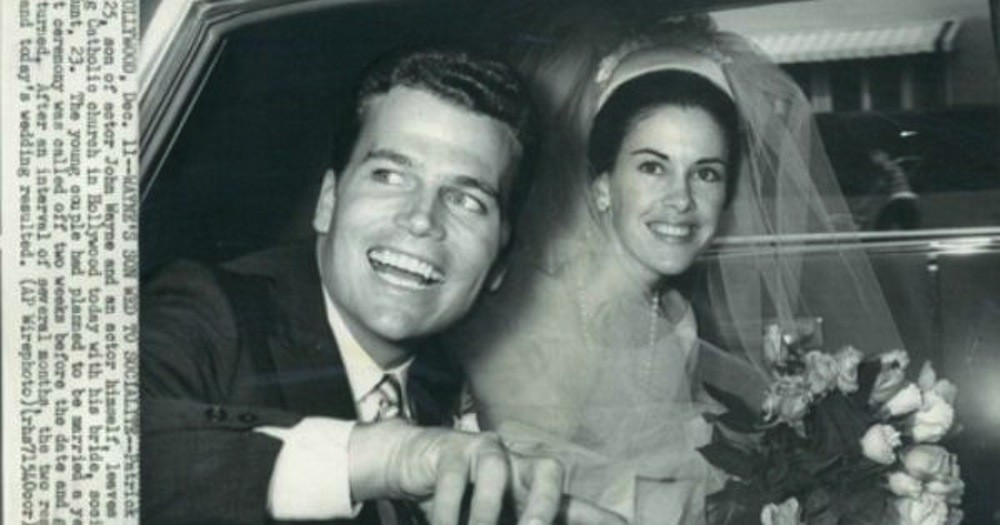 Actor Patrick Wayne departs Christ the King Roman Catholic Church in Hollywood with first wife Peggy Hunt following their December 11, 1965 wedding. Hunt was the daughter of an asphalt company executive while Wayne?s dad was ?The Alamo? protagonist John Wayne. Image Credit: Associated Press
Actor Patrick Wayne departs Christ the King Roman Catholic Church in Hollywood with first wife Peggy Hunt following their December 11, 1965 wedding. Hunt was the daughter of an asphalt company executive while Wayne?s dad was ?The Alamo? protagonist John Wayne. Image Credit: Associated Press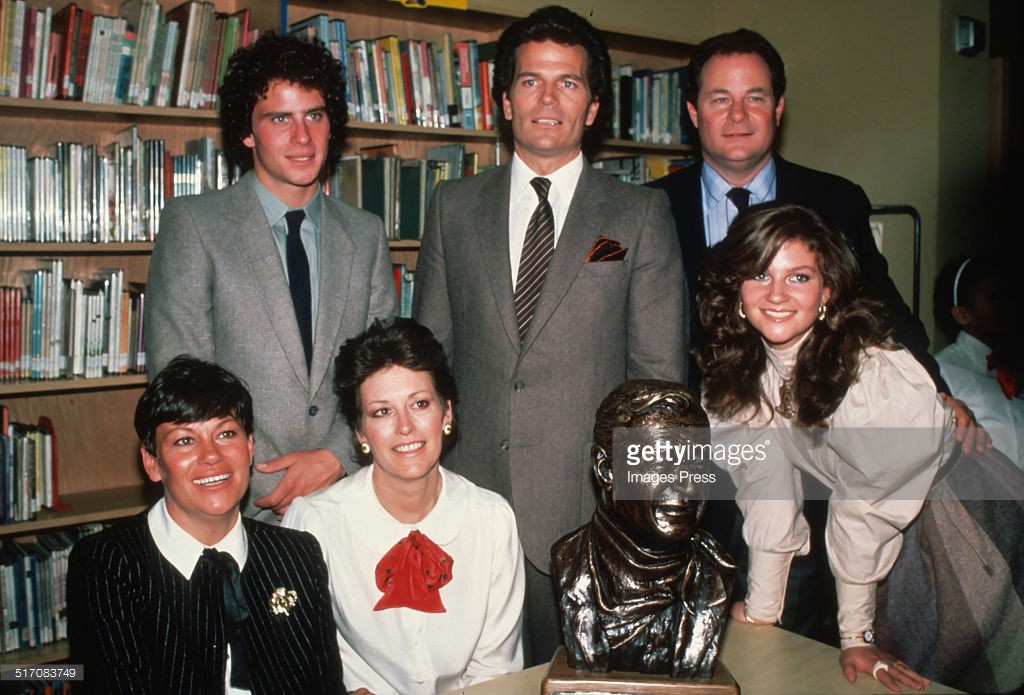 Clockwise from top left: Six of John Wayne?s children ? Ethan Wayne, Patrick Wayne, the late Michael Wayne, Marisa Wayne, Melinda Munoz, and the late Toni La Cava ? attend the dedication ceremony of the John Wayne Elementary School on October 28, 1982 in Brooklyn, New York. Aissa Wayne, the Duke?s first of three kids with Pilar Pallete, is absent. Image Credit: Photography by Robin Platzer / Getty Images
Clockwise from top left: Six of John Wayne?s children ? Ethan Wayne, Patrick Wayne, the late Michael Wayne, Marisa Wayne, Melinda Munoz, and the late Toni La Cava ? attend the dedication ceremony of the John Wayne Elementary School on October 28, 1982 in Brooklyn, New York. Aissa Wayne, the Duke?s first of three kids with Pilar Pallete, is absent. Image Credit: Photography by Robin Platzer / Getty Images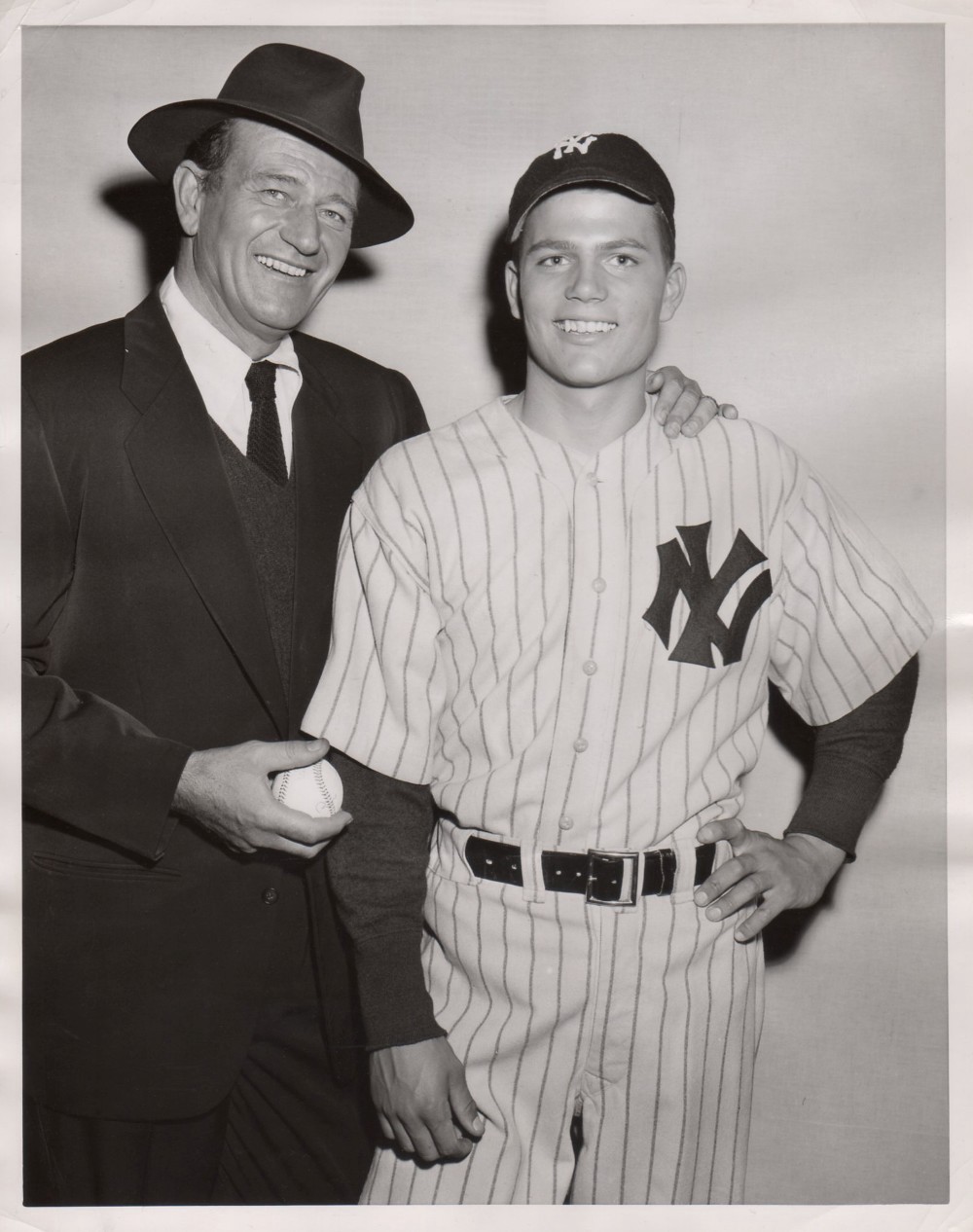 As Mike Cronin, a small town sportswriter attending the World Series, John Wayne poses with son Patrick Wayne in a still from ?Rookie of the Year,? a December 7, 1955 episode of the ?Screen Directors Playhouse? series directed by Wayne?s mentor John Ford. Image Credit: DukeWayne.com forum / Las Bugas collectionClick to watch Patrick Wayne dish about the 10 movies that he filmed with his Congressional Gold Medal-winning father John Wayne and the John Wayne Cancer Institute in this comprehensive video interview conducted around the time of the July 2009 issue of Cowboys & Indians Magazine which featured exclusive tributes from the Duke?s family. Three additional Patrick Wayne interviews can be found if you scroll further below. Video Credit: Cowboys & Indians Magazine
As Mike Cronin, a small town sportswriter attending the World Series, John Wayne poses with son Patrick Wayne in a still from ?Rookie of the Year,? a December 7, 1955 episode of the ?Screen Directors Playhouse? series directed by Wayne?s mentor John Ford. Image Credit: DukeWayne.com forum / Las Bugas collectionClick to watch Patrick Wayne dish about the 10 movies that he filmed with his Congressional Gold Medal-winning father John Wayne and the John Wayne Cancer Institute in this comprehensive video interview conducted around the time of the July 2009 issue of Cowboys & Indians Magazine which featured exclusive tributes from the Duke?s family. Three additional Patrick Wayne interviews can be found if you scroll further below. Video Credit: Cowboys & Indians Magazine
?John Wayne built my career:? Durango prop guys and pistoleros with Chris Mitchum
Chris Mitchum wound up good-naturedly sparring with John Wayne in three westerns filmed in Northwest Mexico ? Chisum?
medium.com
Kung fu stunts and red state politics with Chris Mitchum
The lowdown on John Wayne?s conservative politics, being blackballed by Hollywood liberals, and unprofessional?
medium.com
John Wayne hawks Datril 500, Bristol-Myers? miracle headache remedy
After The Shootist was distributed in August 1976 to glowing critical reviews but disappointing rentals ? nobody wanted?
medium.com
Peter Fonda looks back on father?s iconic performance in Sidney Lumet?s ?12 Angry Men?
Peter Fonda on director Sidney Lumet?s ?12 Angry Men? and the unstoppable fierceness which his father Henry Fonda had?
medium.com
Heart to heart with ?Two and a Half Men? outsider Jennifer Taylor
In her most expansive interview, Charlie Sheen?s former TV fianc talks #MeToo, bad auditions, lactose intolerance?
medium.com
Jeremy Roberts, 2017. All rights reserved. To touch base, email [email protected] and mention which story led you my way. I appreciate it sincerely.


